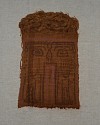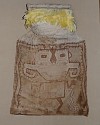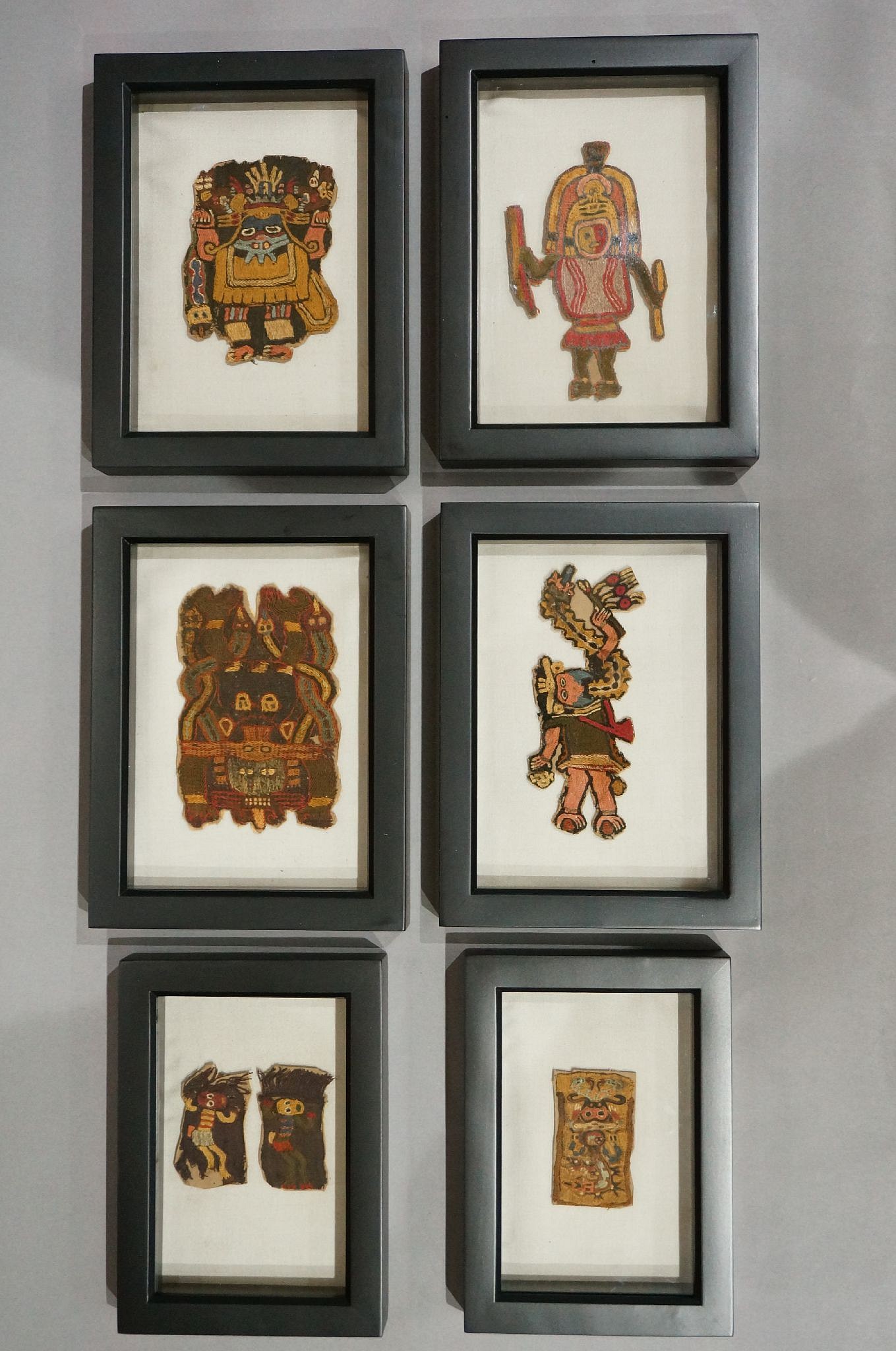
Peru, Paracas Embroidered Group of 6 Textile Sections
These figures represent different shamans in different states of transformation. The same subjects are illustrated in Alfredo Taullard’s Tejidos y Ponchos Indigenas de Sudamérica, Buenos Aires: Editorial Guillermo Kraft Limitada, 1949. These Paracas sections were excavated in the 1920s and were sent to various museum collections in Europe and the US.
Mounted on cardboard backing and reframed.
Acquired by David Bernstein in 2019.
Period: Peru, Paracas, South Coast, c. 200 - 100 BC
Period: Peru, Paracas, South Coast, c. 200 - 100 BC
Media: Textile
Dimensions: Length varies from 3 to 4 inches.
$12,000
n9048
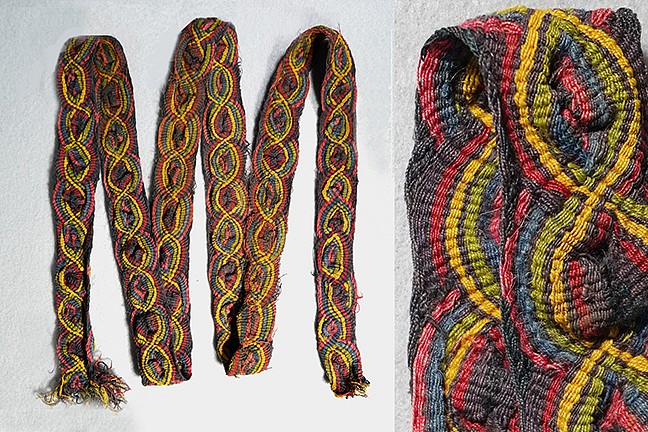


Peru, Paracas Plaited Sash with Double-Helix Pattern
This plaited triple-cloth turban sash is woven with vibrant shades of green, blue, yellow, pink, red, and brown. The intertwining double-helix pattern may represent interlocking serpents. Most Andean sashes are flat but the clever artisan who created this sash used the plaiting technique to create a three-dimensional structure resembling a snake. It is also possible that this design also imitates a tie-dye technique with the tied-off center. Acquired in 1999 from a California collector.
Period: Peru, Paracas, South Coast Early Intermediate Period, Phase II, c. AD 100 - 200
Period: Peru, Paracas, South Coast Early Intermediate Period, Phase II, c. AD 100 - 200
Dimensions: Length: 61 inches x Width: 1.25 inches
$6,500
99513
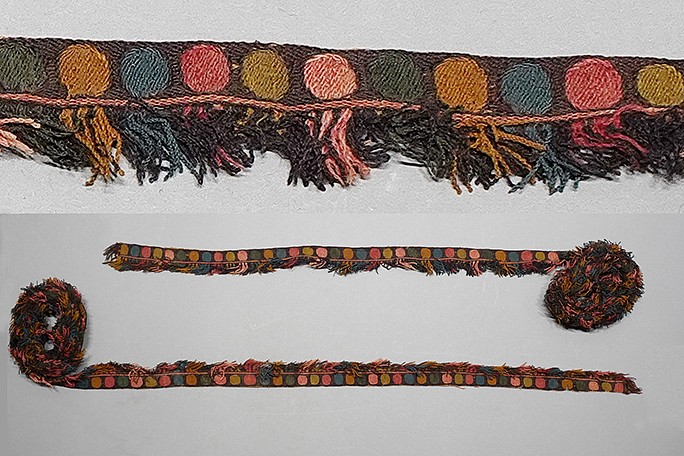


Peru, Paracas Pair of Embroidered Fringes with Alternating Colored Circles
The colored circles repeat in sections of six in blue, green, pinks and gold. All four ends are finished. The outer fringe extension is colored as the same circles. There are 145 circles on each fringe.
Beautiful colors and finished on each end. Unmounted. Private California collection, acquired in 1980.
Period: Peru, Paracas-Ocucaje 10, or Nasca 1, South Coast, c. BC 100 - AD 100
Period: Peru, Paracas-Ocucaje 10, or Nasca 1, South Coast, c. BC 100 - AD 100
Media: Textile
Dimensions: Length:70" X Width: 1" for each fringe.
$4,900
T-20
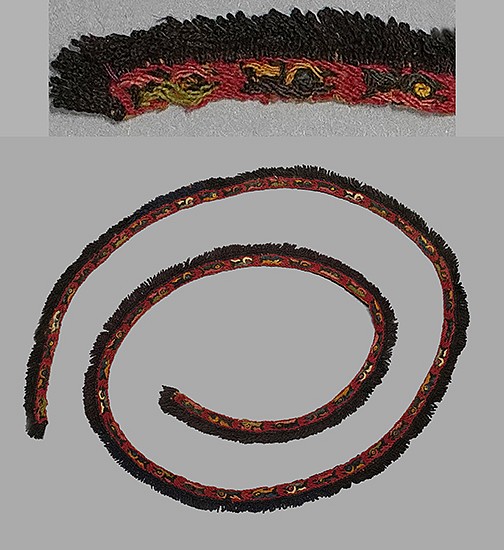



Peru, Paracas Miniature Embroidered Fringe with 59 Killer Whales
Weaving technique: embroidery with looped fringe.
This small-scale fringe was a border to a miniature garment. The whales repeat in alternating colors in sets of sections of seven whales. There is a solid dark blue-black outer fringe in excellent condition, which is finished at both ends. Traditionally, young children in the Andes do this type of embroidery, as they are the only ones who can work with such small detail. Acquired in 1998 from a California collector prior to the 1980s. Both ends are finished to make a complete fringe. Unmounted.
Period: Peru, Paracas, South Coast, c. 100 BC - AD 100
Media: Textile
Dimensions: Length: 35” x Width: 3/16”
$1,900
T-19






Peru, Paracas Double-woven Plaited Sash
This plaited colorful cloth turban sash is woven with vibrant shades of green, blue, yellow, pink, red, and brown. The triangle pattern when set next to a corresponding triangle creates a rectangle. Acquired in 1999 from a California collector prior to 1980's
Period: Peru, Nasca, Proto Phase, South Coast, c. 100 BC - AD 200
Period: Peru, Nasca, Proto Phase, South Coast, c. 100 BC - AD 200
Media: Textile
Dimensions: Length: 55 inches x Width: 1 inch
$6,500
99511
![Peru, Late Paracas/Early Nasca Embroidered Section with Four Colorful Monkey Deities in Alternating Colors on a Gold Ground
This textile portrays a series of ecstatic shamans as Animal Impersonators. The main figures, depicted with flying wings, are referred to as monkey deities because they have opposing toes. The bright, abstract color combinations not normally found in nature and the dense shamanic imagery such as double-headed serpents, flint knives, and trophy heads, could easily have been the result of a psychedelic journey. Note: Psychiatrist Oscar Janiger’s studies in the 1950s revealed that that LSD “not only radically changed the [artist’s] style but also gave them new depths to understand the use of color, form, light, or the way these things are viewed in a frame of reference.†(Dobkin/Janiger, 2003, p.80]. The beautifully contrasting colors, and the fluidity of the figure-ground relationship of this Paracas textile connotes a psychedelic influence on the ancient Paracas and Nasca people -possibly that of psilocybin. Shamanic animal transformation in Andean art represents the journey to the afterlife by way of psychic flight.
From top to bottom: The top figure wears a grey puma headdress with Chile peppers, a white nose ornament, and a tunic with a step volute border. Serpents with suspended kidney beans flank him on both sides, and another serpent emanates from his mouth. The second wears a diadem on his forehead, a cloak, and a loin cloth, and is surrounded by three animal heads. He wears a gold mask with a serpent emanating from his mouth and holds a trophy head in one hand and a flint knife in the other. The following figure repeats the compositional structure of the first figure but has a completely different color arrangement. The last figure repeats the structure of the second figure, also in completely different colors. No two figures are the same, and the curvature of the snakes created in alternating colors conveys a sense of motion. Another section from the same textile is in the Israel Museum, Jerusalem. Period: Peru, Paracas-Ocucaje 10, or Nasca 1, South Coast, c. BC 100 - AD 100
Period: Peru, Paracas-Ocucaje 10, or Nasca 1, South Coast, c. BC 100 - AD 100
Media: Textile
Dimensions: Textile, Length: 24" x Width: 2 3/4" Plexiglas frame, Length: 27"x Width: 5 1/2"
Price Upon Request
pp008](/images/16081_h2048w2048gt.5.jpg)
![Peru, Late Paracas/Early Nasca Embroidered Section with Four Colorful Monkey Deities in Alternating Colors on a Gold Ground
This textile portrays a series of ecstatic shamans as Animal Impersonators. The main figures, depicted with flying wings, are referred to as monkey deities because they have opposing toes. The bright, abstract color combinations not normally found in nature and the dense shamanic imagery such as double-headed serpents, flint knives, and trophy heads, could easily have been the result of a psychedelic journey. Note: Psychiatrist Oscar Janiger’s studies in the 1950s revealed that that LSD “not only radically changed the [artist’s] style but also gave them new depths to understand the use of color, form, light, or the way these things are viewed in a frame of reference.†(Dobkin/Janiger, 2003, p.80]. The beautifully contrasting colors, and the fluidity of the figure-ground relationship of this Paracas textile connotes a psychedelic influence on the ancient Paracas and Nasca people -possibly that of psilocybin. Shamanic animal transformation in Andean art represents the journey to the afterlife by way of psychic flight.
From top to bottom: The top figure wears a grey puma headdress with Chile peppers, a white nose ornament, and a tunic with a step volute border. Serpents with suspended kidney beans flank him on both sides, and another serpent emanates from his mouth. The second wears a diadem on his forehead, a cloak, and a loin cloth, and is surrounded by three animal heads. He wears a gold mask with a serpent emanating from his mouth and holds a trophy head in one hand and a flint knife in the other. The following figure repeats the compositional structure of the first figure but has a completely different color arrangement. The last figure repeats the structure of the second figure, also in completely different colors. No two figures are the same, and the curvature of the snakes created in alternating colors conveys a sense of motion. Another section from the same textile is in the Israel Museum, Jerusalem. Period: Peru, Paracas-Ocucaje 10, or Nasca 1, South Coast, c. BC 100 - AD 100
Period: Peru, Paracas-Ocucaje 10, or Nasca 1, South Coast, c. BC 100 - AD 100
Media: Textile
Dimensions: Textile, Length: 24" x Width: 2 3/4" Plexiglas frame, Length: 27"x Width: 5 1/2"
Price Upon Request
pp008](/images/16081_h100w100gt.5.jpg)
![Peru, Late Paracas/Early Nasca Embroidered Section with Four Colorful Monkey Deities in Alternating Colors on a Gold Ground
This textile portrays a series of ecstatic shamans as Animal Impersonators. The main figures, depicted with flying wings, are referred to as monkey deities because they have opposing toes. The bright, abstract color combinations not normally found in nature and the dense shamanic imagery such as double-headed serpents, flint knives, and trophy heads, could easily have been the result of a psychedelic journey. Note: Psychiatrist Oscar Janiger’s studies in the 1950s revealed that that LSD “not only radically changed the [artist’s] style but also gave them new depths to understand the use of color, form, light, or the way these things are viewed in a frame of reference.†(Dobkin/Janiger, 2003, p.80]. The beautifully contrasting colors, and the fluidity of the figure-ground relationship of this Paracas textile connotes a psychedelic influence on the ancient Paracas and Nasca people -possibly that of psilocybin. Shamanic animal transformation in Andean art represents the journey to the afterlife by way of psychic flight.
From top to bottom: The top figure wears a grey puma headdress with Chile peppers, a white nose ornament, and a tunic with a step volute border. Serpents with suspended kidney beans flank him on both sides, and another serpent emanates from his mouth. The second wears a diadem on his forehead, a cloak, and a loin cloth, and is surrounded by three animal heads. He wears a gold mask with a serpent emanating from his mouth and holds a trophy head in one hand and a flint knife in the other. The following figure repeats the compositional structure of the first figure but has a completely different color arrangement. The last figure repeats the structure of the second figure, also in completely different colors. No two figures are the same, and the curvature of the snakes created in alternating colors conveys a sense of motion. Another section from the same textile is in the Israel Museum, Jerusalem. Period: Peru, Paracas-Ocucaje 10, or Nasca 1, South Coast, c. BC 100 - AD 100
Period: Peru, Paracas-Ocucaje 10, or Nasca 1, South Coast, c. BC 100 - AD 100
Media: Textile
Dimensions: Textile, Length: 24" x Width: 2 3/4" Plexiglas frame, Length: 27"x Width: 5 1/2"
Price Upon Request
pp008](/images/16082_h100w100gt.5.jpg)
![Peru, Late Paracas/Early Nasca Embroidered Section with Four Colorful Monkey Deities in Alternating Colors on a Gold Ground
This textile portrays a series of ecstatic shamans as Animal Impersonators. The main figures, depicted with flying wings, are referred to as monkey deities because they have opposing toes. The bright, abstract color combinations not normally found in nature and the dense shamanic imagery such as double-headed serpents, flint knives, and trophy heads, could easily have been the result of a psychedelic journey. Note: Psychiatrist Oscar Janiger’s studies in the 1950s revealed that that LSD “not only radically changed the [artist’s] style but also gave them new depths to understand the use of color, form, light, or the way these things are viewed in a frame of reference.†(Dobkin/Janiger, 2003, p.80]. The beautifully contrasting colors, and the fluidity of the figure-ground relationship of this Paracas textile connotes a psychedelic influence on the ancient Paracas and Nasca people -possibly that of psilocybin. Shamanic animal transformation in Andean art represents the journey to the afterlife by way of psychic flight.
From top to bottom: The top figure wears a grey puma headdress with Chile peppers, a white nose ornament, and a tunic with a step volute border. Serpents with suspended kidney beans flank him on both sides, and another serpent emanates from his mouth. The second wears a diadem on his forehead, a cloak, and a loin cloth, and is surrounded by three animal heads. He wears a gold mask with a serpent emanating from his mouth and holds a trophy head in one hand and a flint knife in the other. The following figure repeats the compositional structure of the first figure but has a completely different color arrangement. The last figure repeats the structure of the second figure, also in completely different colors. No two figures are the same, and the curvature of the snakes created in alternating colors conveys a sense of motion. Another section from the same textile is in the Israel Museum, Jerusalem. Period: Peru, Paracas-Ocucaje 10, or Nasca 1, South Coast, c. BC 100 - AD 100
Period: Peru, Paracas-Ocucaje 10, or Nasca 1, South Coast, c. BC 100 - AD 100
Media: Textile
Dimensions: Textile, Length: 24" x Width: 2 3/4" Plexiglas frame, Length: 27"x Width: 5 1/2"
Price Upon Request
pp008](/images/16085_h100w100gt.5.jpg)
![Peru, Late Paracas/Early Nasca Embroidered Section with Four Colorful Monkey Deities in Alternating Colors on a Gold Ground
This textile portrays a series of ecstatic shamans as Animal Impersonators. The main figures, depicted with flying wings, are referred to as monkey deities because they have opposing toes. The bright, abstract color combinations not normally found in nature and the dense shamanic imagery such as double-headed serpents, flint knives, and trophy heads, could easily have been the result of a psychedelic journey. Note: Psychiatrist Oscar Janiger’s studies in the 1950s revealed that that LSD “not only radically changed the [artist’s] style but also gave them new depths to understand the use of color, form, light, or the way these things are viewed in a frame of reference.†(Dobkin/Janiger, 2003, p.80]. The beautifully contrasting colors, and the fluidity of the figure-ground relationship of this Paracas textile connotes a psychedelic influence on the ancient Paracas and Nasca people -possibly that of psilocybin. Shamanic animal transformation in Andean art represents the journey to the afterlife by way of psychic flight.
From top to bottom: The top figure wears a grey puma headdress with Chile peppers, a white nose ornament, and a tunic with a step volute border. Serpents with suspended kidney beans flank him on both sides, and another serpent emanates from his mouth. The second wears a diadem on his forehead, a cloak, and a loin cloth, and is surrounded by three animal heads. He wears a gold mask with a serpent emanating from his mouth and holds a trophy head in one hand and a flint knife in the other. The following figure repeats the compositional structure of the first figure but has a completely different color arrangement. The last figure repeats the structure of the second figure, also in completely different colors. No two figures are the same, and the curvature of the snakes created in alternating colors conveys a sense of motion. Another section from the same textile is in the Israel Museum, Jerusalem. Period: Peru, Paracas-Ocucaje 10, or Nasca 1, South Coast, c. BC 100 - AD 100
Period: Peru, Paracas-Ocucaje 10, or Nasca 1, South Coast, c. BC 100 - AD 100
Media: Textile
Dimensions: Textile, Length: 24" x Width: 2 3/4" Plexiglas frame, Length: 27"x Width: 5 1/2"
Price Upon Request
pp008](/images/15195_h100w100gt.5.jpg)
![Peru, Late Paracas/Early Nasca Embroidered Section with Four Colorful Monkey Deities in Alternating Colors on a Gold Ground
This textile portrays a series of ecstatic shamans as Animal Impersonators. The main figures, depicted with flying wings, are referred to as monkey deities because they have opposing toes. The bright, abstract color combinations not normally found in nature and the dense shamanic imagery such as double-headed serpents, flint knives, and trophy heads, could easily have been the result of a psychedelic journey. Note: Psychiatrist Oscar Janiger’s studies in the 1950s revealed that that LSD “not only radically changed the [artist’s] style but also gave them new depths to understand the use of color, form, light, or the way these things are viewed in a frame of reference.†(Dobkin/Janiger, 2003, p.80]. The beautifully contrasting colors, and the fluidity of the figure-ground relationship of this Paracas textile connotes a psychedelic influence on the ancient Paracas and Nasca people -possibly that of psilocybin. Shamanic animal transformation in Andean art represents the journey to the afterlife by way of psychic flight.
From top to bottom: The top figure wears a grey puma headdress with Chile peppers, a white nose ornament, and a tunic with a step volute border. Serpents with suspended kidney beans flank him on both sides, and another serpent emanates from his mouth. The second wears a diadem on his forehead, a cloak, and a loin cloth, and is surrounded by three animal heads. He wears a gold mask with a serpent emanating from his mouth and holds a trophy head in one hand and a flint knife in the other. The following figure repeats the compositional structure of the first figure but has a completely different color arrangement. The last figure repeats the structure of the second figure, also in completely different colors. No two figures are the same, and the curvature of the snakes created in alternating colors conveys a sense of motion. Another section from the same textile is in the Israel Museum, Jerusalem. Period: Peru, Paracas-Ocucaje 10, or Nasca 1, South Coast, c. BC 100 - AD 100
Period: Peru, Paracas-Ocucaje 10, or Nasca 1, South Coast, c. BC 100 - AD 100
Media: Textile
Dimensions: Textile, Length: 24" x Width: 2 3/4" Plexiglas frame, Length: 27"x Width: 5 1/2"
Price Upon Request
pp008](/images/15197_h100w100gt.5.jpg)
![Peru, Late Paracas/Early Nasca Embroidered Section with Four Colorful Monkey Deities in Alternating Colors on a Gold Ground
This textile portrays a series of ecstatic shamans as Animal Impersonators. The main figures, depicted with flying wings, are referred to as monkey deities because they have opposing toes. The bright, abstract color combinations not normally found in nature and the dense shamanic imagery such as double-headed serpents, flint knives, and trophy heads, could easily have been the result of a psychedelic journey. Note: Psychiatrist Oscar Janiger’s studies in the 1950s revealed that that LSD “not only radically changed the [artist’s] style but also gave them new depths to understand the use of color, form, light, or the way these things are viewed in a frame of reference.†(Dobkin/Janiger, 2003, p.80]. The beautifully contrasting colors, and the fluidity of the figure-ground relationship of this Paracas textile connotes a psychedelic influence on the ancient Paracas and Nasca people -possibly that of psilocybin. Shamanic animal transformation in Andean art represents the journey to the afterlife by way of psychic flight.
From top to bottom: The top figure wears a grey puma headdress with Chile peppers, a white nose ornament, and a tunic with a step volute border. Serpents with suspended kidney beans flank him on both sides, and another serpent emanates from his mouth. The second wears a diadem on his forehead, a cloak, and a loin cloth, and is surrounded by three animal heads. He wears a gold mask with a serpent emanating from his mouth and holds a trophy head in one hand and a flint knife in the other. The following figure repeats the compositional structure of the first figure but has a completely different color arrangement. The last figure repeats the structure of the second figure, also in completely different colors. No two figures are the same, and the curvature of the snakes created in alternating colors conveys a sense of motion. Another section from the same textile is in the Israel Museum, Jerusalem. Period: Peru, Paracas-Ocucaje 10, or Nasca 1, South Coast, c. BC 100 - AD 100
Period: Peru, Paracas-Ocucaje 10, or Nasca 1, South Coast, c. BC 100 - AD 100
Media: Textile
Dimensions: Textile, Length: 24" x Width: 2 3/4" Plexiglas frame, Length: 27"x Width: 5 1/2"
Price Upon Request
pp008](/images/16084_h100w100gt.5.jpg)
![Peru, Late Paracas/Early Nasca Embroidered Section with Four Colorful Monkey Deities in Alternating Colors on a Gold Ground
This textile portrays a series of ecstatic shamans as Animal Impersonators. The main figures, depicted with flying wings, are referred to as monkey deities because they have opposing toes. The bright, abstract color combinations not normally found in nature and the dense shamanic imagery such as double-headed serpents, flint knives, and trophy heads, could easily have been the result of a psychedelic journey. Note: Psychiatrist Oscar Janiger’s studies in the 1950s revealed that that LSD “not only radically changed the [artist’s] style but also gave them new depths to understand the use of color, form, light, or the way these things are viewed in a frame of reference.†(Dobkin/Janiger, 2003, p.80]. The beautifully contrasting colors, and the fluidity of the figure-ground relationship of this Paracas textile connotes a psychedelic influence on the ancient Paracas and Nasca people -possibly that of psilocybin. Shamanic animal transformation in Andean art represents the journey to the afterlife by way of psychic flight.
From top to bottom: The top figure wears a grey puma headdress with Chile peppers, a white nose ornament, and a tunic with a step volute border. Serpents with suspended kidney beans flank him on both sides, and another serpent emanates from his mouth. The second wears a diadem on his forehead, a cloak, and a loin cloth, and is surrounded by three animal heads. He wears a gold mask with a serpent emanating from his mouth and holds a trophy head in one hand and a flint knife in the other. The following figure repeats the compositional structure of the first figure but has a completely different color arrangement. The last figure repeats the structure of the second figure, also in completely different colors. No two figures are the same, and the curvature of the snakes created in alternating colors conveys a sense of motion. Another section from the same textile is in the Israel Museum, Jerusalem. Period: Peru, Paracas-Ocucaje 10, or Nasca 1, South Coast, c. BC 100 - AD 100
Period: Peru, Paracas-Ocucaje 10, or Nasca 1, South Coast, c. BC 100 - AD 100
Media: Textile
Dimensions: Textile, Length: 24" x Width: 2 3/4" Plexiglas frame, Length: 27"x Width: 5 1/2"
Price Upon Request
pp008](/images/15198_h100w100gt.5.jpg)
![Peru, Late Paracas/Early Nasca Embroidered Section with Four Colorful Monkey Deities in Alternating Colors on a Gold Ground
This textile portrays a series of ecstatic shamans as Animal Impersonators. The main figures, depicted with flying wings, are referred to as monkey deities because they have opposing toes. The bright, abstract color combinations not normally found in nature and the dense shamanic imagery such as double-headed serpents, flint knives, and trophy heads, could easily have been the result of a psychedelic journey. Note: Psychiatrist Oscar Janiger’s studies in the 1950s revealed that that LSD “not only radically changed the [artist’s] style but also gave them new depths to understand the use of color, form, light, or the way these things are viewed in a frame of reference.†(Dobkin/Janiger, 2003, p.80]. The beautifully contrasting colors, and the fluidity of the figure-ground relationship of this Paracas textile connotes a psychedelic influence on the ancient Paracas and Nasca people -possibly that of psilocybin. Shamanic animal transformation in Andean art represents the journey to the afterlife by way of psychic flight.
From top to bottom: The top figure wears a grey puma headdress with Chile peppers, a white nose ornament, and a tunic with a step volute border. Serpents with suspended kidney beans flank him on both sides, and another serpent emanates from his mouth. The second wears a diadem on his forehead, a cloak, and a loin cloth, and is surrounded by three animal heads. He wears a gold mask with a serpent emanating from his mouth and holds a trophy head in one hand and a flint knife in the other. The following figure repeats the compositional structure of the first figure but has a completely different color arrangement. The last figure repeats the structure of the second figure, also in completely different colors. No two figures are the same, and the curvature of the snakes created in alternating colors conveys a sense of motion. Another section from the same textile is in the Israel Museum, Jerusalem. Period: Peru, Paracas-Ocucaje 10, or Nasca 1, South Coast, c. BC 100 - AD 100
Period: Peru, Paracas-Ocucaje 10, or Nasca 1, South Coast, c. BC 100 - AD 100
Media: Textile
Dimensions: Textile, Length: 24" x Width: 2 3/4" Plexiglas frame, Length: 27"x Width: 5 1/2"
Price Upon Request
pp008](/images/16086_h100w100gt.5.jpg)
![Peru, Late Paracas/Early Nasca Embroidered Section with Four Colorful Monkey Deities in Alternating Colors on a Gold Ground
This textile portrays a series of ecstatic shamans as Animal Impersonators. The main figures, depicted with flying wings, are referred to as monkey deities because they have opposing toes. The bright, abstract color combinations not normally found in nature and the dense shamanic imagery such as double-headed serpents, flint knives, and trophy heads, could easily have been the result of a psychedelic journey. Note: Psychiatrist Oscar Janiger’s studies in the 1950s revealed that that LSD “not only radically changed the [artist’s] style but also gave them new depths to understand the use of color, form, light, or the way these things are viewed in a frame of reference.†(Dobkin/Janiger, 2003, p.80]. The beautifully contrasting colors, and the fluidity of the figure-ground relationship of this Paracas textile connotes a psychedelic influence on the ancient Paracas and Nasca people -possibly that of psilocybin. Shamanic animal transformation in Andean art represents the journey to the afterlife by way of psychic flight.
From top to bottom: The top figure wears a grey puma headdress with Chile peppers, a white nose ornament, and a tunic with a step volute border. Serpents with suspended kidney beans flank him on both sides, and another serpent emanates from his mouth. The second wears a diadem on his forehead, a cloak, and a loin cloth, and is surrounded by three animal heads. He wears a gold mask with a serpent emanating from his mouth and holds a trophy head in one hand and a flint knife in the other. The following figure repeats the compositional structure of the first figure but has a completely different color arrangement. The last figure repeats the structure of the second figure, also in completely different colors. No two figures are the same, and the curvature of the snakes created in alternating colors conveys a sense of motion. Another section from the same textile is in the Israel Museum, Jerusalem. Period: Peru, Paracas-Ocucaje 10, or Nasca 1, South Coast, c. BC 100 - AD 100
Period: Peru, Paracas-Ocucaje 10, or Nasca 1, South Coast, c. BC 100 - AD 100
Media: Textile
Dimensions: Textile, Length: 24" x Width: 2 3/4" Plexiglas frame, Length: 27"x Width: 5 1/2"
Price Upon Request
pp008](/images/15200_h100w100gt.5.jpg)
![Peru, Late Paracas/Early Nasca Embroidered Section with Four Colorful Monkey Deities in Alternating Colors on a Gold Ground
This textile portrays a series of ecstatic shamans as Animal Impersonators. The main figures, depicted with flying wings, are referred to as monkey deities because they have opposing toes. The bright, abstract color combinations not normally found in nature and the dense shamanic imagery such as double-headed serpents, flint knives, and trophy heads, could easily have been the result of a psychedelic journey. Note: Psychiatrist Oscar Janiger’s studies in the 1950s revealed that that LSD “not only radically changed the [artist’s] style but also gave them new depths to understand the use of color, form, light, or the way these things are viewed in a frame of reference.†(Dobkin/Janiger, 2003, p.80]. The beautifully contrasting colors, and the fluidity of the figure-ground relationship of this Paracas textile connotes a psychedelic influence on the ancient Paracas and Nasca people -possibly that of psilocybin. Shamanic animal transformation in Andean art represents the journey to the afterlife by way of psychic flight.
From top to bottom: The top figure wears a grey puma headdress with Chile peppers, a white nose ornament, and a tunic with a step volute border. Serpents with suspended kidney beans flank him on both sides, and another serpent emanates from his mouth. The second wears a diadem on his forehead, a cloak, and a loin cloth, and is surrounded by three animal heads. He wears a gold mask with a serpent emanating from his mouth and holds a trophy head in one hand and a flint knife in the other. The following figure repeats the compositional structure of the first figure but has a completely different color arrangement. The last figure repeats the structure of the second figure, also in completely different colors. No two figures are the same, and the curvature of the snakes created in alternating colors conveys a sense of motion. Another section from the same textile is in the Israel Museum, Jerusalem. Period: Peru, Paracas-Ocucaje 10, or Nasca 1, South Coast, c. BC 100 - AD 100
Period: Peru, Paracas-Ocucaje 10, or Nasca 1, South Coast, c. BC 100 - AD 100
Media: Textile
Dimensions: Textile, Length: 24" x Width: 2 3/4" Plexiglas frame, Length: 27"x Width: 5 1/2"
Price Upon Request
pp008](/images/15199_h100w100gt.5.jpg)
![Peru, Late Paracas/Early Nasca Embroidered Section with Four Colorful Monkey Deities in Alternating Colors on a Gold Ground
This textile portrays a series of ecstatic shamans as Animal Impersonators. The main figures, depicted with flying wings, are referred to as monkey deities because they have opposing toes. The bright, abstract color combinations not normally found in nature and the dense shamanic imagery such as double-headed serpents, flint knives, and trophy heads, could easily have been the result of a psychedelic journey. Note: Psychiatrist Oscar Janiger’s studies in the 1950s revealed that that LSD “not only radically changed the [artist’s] style but also gave them new depths to understand the use of color, form, light, or the way these things are viewed in a frame of reference.†(Dobkin/Janiger, 2003, p.80]. The beautifully contrasting colors, and the fluidity of the figure-ground relationship of this Paracas textile connotes a psychedelic influence on the ancient Paracas and Nasca people -possibly that of psilocybin. Shamanic animal transformation in Andean art represents the journey to the afterlife by way of psychic flight.
From top to bottom: The top figure wears a grey puma headdress with Chile peppers, a white nose ornament, and a tunic with a step volute border. Serpents with suspended kidney beans flank him on both sides, and another serpent emanates from his mouth. The second wears a diadem on his forehead, a cloak, and a loin cloth, and is surrounded by three animal heads. He wears a gold mask with a serpent emanating from his mouth and holds a trophy head in one hand and a flint knife in the other. The following figure repeats the compositional structure of the first figure but has a completely different color arrangement. The last figure repeats the structure of the second figure, also in completely different colors. No two figures are the same, and the curvature of the snakes created in alternating colors conveys a sense of motion. Another section from the same textile is in the Israel Museum, Jerusalem. Period: Peru, Paracas-Ocucaje 10, or Nasca 1, South Coast, c. BC 100 - AD 100
Period: Peru, Paracas-Ocucaje 10, or Nasca 1, South Coast, c. BC 100 - AD 100
Media: Textile
Dimensions: Textile, Length: 24" x Width: 2 3/4" Plexiglas frame, Length: 27"x Width: 5 1/2"
Price Upon Request
pp008](/images/16083_h100w100gt.5.jpg)
![Peru, Late Paracas/Early Nasca Embroidered Section with Four Colorful Monkey Deities in Alternating Colors on a Gold Ground
This textile portrays a series of ecstatic shamans as Animal Impersonators. The main figures, depicted with flying wings, are referred to as monkey deities because they have opposing toes. The bright, abstract color combinations not normally found in nature and the dense shamanic imagery such as double-headed serpents, flint knives, and trophy heads, could easily have been the result of a psychedelic journey. Note: Psychiatrist Oscar Janiger’s studies in the 1950s revealed that that LSD “not only radically changed the [artist’s] style but also gave them new depths to understand the use of color, form, light, or the way these things are viewed in a frame of reference.†(Dobkin/Janiger, 2003, p.80]. The beautifully contrasting colors, and the fluidity of the figure-ground relationship of this Paracas textile connotes a psychedelic influence on the ancient Paracas and Nasca people -possibly that of psilocybin. Shamanic animal transformation in Andean art represents the journey to the afterlife by way of psychic flight.
From top to bottom: The top figure wears a grey puma headdress with Chile peppers, a white nose ornament, and a tunic with a step volute border. Serpents with suspended kidney beans flank him on both sides, and another serpent emanates from his mouth. The second wears a diadem on his forehead, a cloak, and a loin cloth, and is surrounded by three animal heads. He wears a gold mask with a serpent emanating from his mouth and holds a trophy head in one hand and a flint knife in the other. The following figure repeats the compositional structure of the first figure but has a completely different color arrangement. The last figure repeats the structure of the second figure, also in completely different colors. No two figures are the same, and the curvature of the snakes created in alternating colors conveys a sense of motion. Another section from the same textile is in the Israel Museum, Jerusalem. Period: Peru, Paracas-Ocucaje 10, or Nasca 1, South Coast, c. BC 100 - AD 100
Period: Peru, Paracas-Ocucaje 10, or Nasca 1, South Coast, c. BC 100 - AD 100
Media: Textile
Dimensions: Textile, Length: 24" x Width: 2 3/4" Plexiglas frame, Length: 27"x Width: 5 1/2"
Price Upon Request
pp008](/images/15201_h100w100gt.5.jpg)
Peru, Late Paracas/Early Nasca Embroidered Section with Four Colorful Monkey Deities in Alternating Colors on a Gold Ground
This textile portrays a series of ecstatic shamans as Animal Impersonators. The main figures, depicted with flying wings, are referred to as monkey deities because they have opposing toes. The bright, abstract color combinations not normally found in nature and the dense shamanic imagery such as double-headed serpents, flint knives, and trophy heads, could easily have been the result of a psychedelic journey. Note: Psychiatrist Oscar Janiger’s studies in the 1950s revealed that that LSD “not only radically changed the [artist’s] style but also gave them new depths to understand the use of color, form, light, or the way these things are viewed in a frame of reference.†(Dobkin/Janiger, 2003, p.80]. The beautifully contrasting colors, and the fluidity of the figure-ground relationship of this Paracas textile connotes a psychedelic influence on the ancient Paracas and Nasca people -possibly that of psilocybin. Shamanic animal transformation in Andean art represents the journey to the afterlife by way of psychic flight.
From top to bottom: The top figure wears a grey puma headdress with Chile peppers, a white nose ornament, and a tunic with a step volute border. Serpents with suspended kidney beans flank him on both sides, and another serpent emanates from his mouth. The second wears a diadem on his forehead, a cloak, and a loin cloth, and is surrounded by three animal heads. He wears a gold mask with a serpent emanating from his mouth and holds a trophy head in one hand and a flint knife in the other. The following figure repeats the compositional structure of the first figure but has a completely different color arrangement. The last figure repeats the structure of the second figure, also in completely different colors. No two figures are the same, and the curvature of the snakes created in alternating colors conveys a sense of motion. Another section from the same textile is in the Israel Museum, Jerusalem.
Period: Peru, Paracas-Ocucaje 10, or Nasca 1, South Coast, c. BC 100 - AD 100
Period: Peru, Paracas-Ocucaje 10, or Nasca 1, South Coast, c. BC 100 - AD 100
Media: Textile
Dimensions: Textile, Length: 24" x Width: 2 3/4"
Plexiglas frame, Length: 27"x Width: 5 1/2"
Price Upon Request
pp008
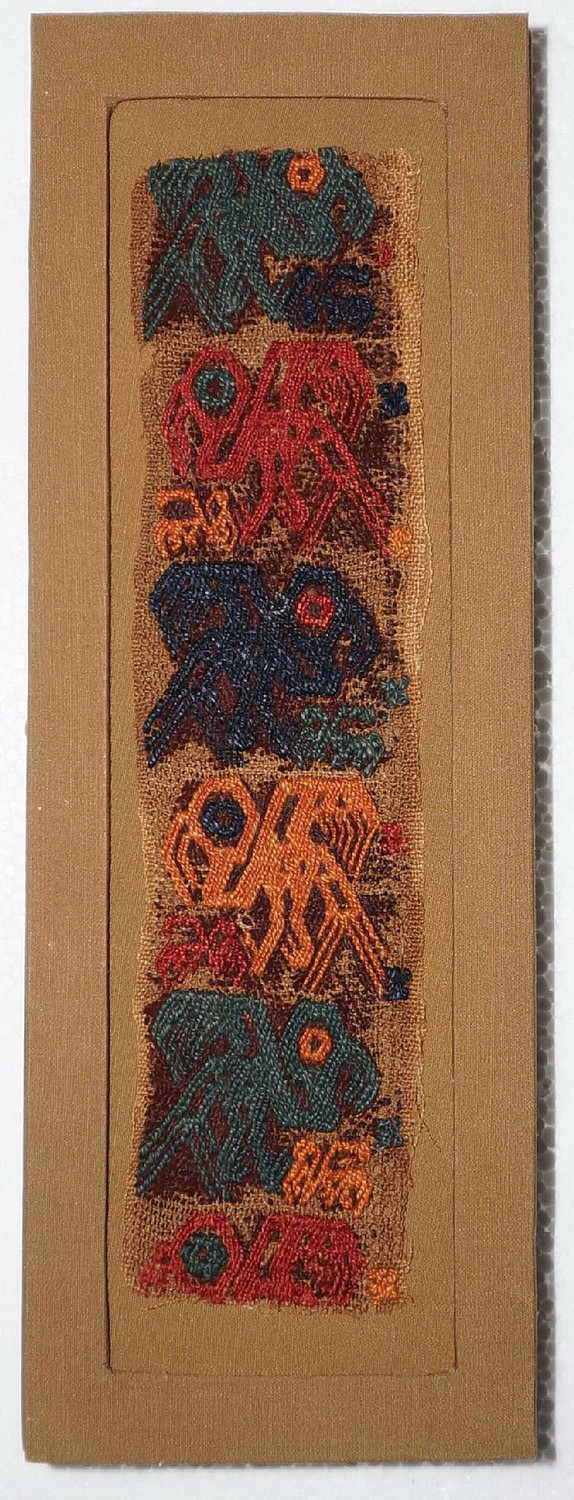





Peru, Paracas Embroidered Section with 5 Condors
This embroidery textile is decorated with five mythical birds of prey in red, green, orange, and dark blue on plain cotton. In front of each large bird is a miniature bird in a contrasting color. This textile is illustrated in ANCIENT PERUVIAN TEXTILES by Ferdinand Anton, 1984, in plate 52. Ferdinand Anton Collection prior to 1980. Excellent color, with slight unraveling at the edges.
Pressure mounted in a Plexiglas frame.
Period: Peru, Paracas, South Coast, c. 500 - 200 BC
Period: Peru, Paracas, South Coast, c. 500 - 200 BC
Media: Textile
Dimensions: Length:2 1/4" x Height: 7 1/2 "
Price Upon Request
92071
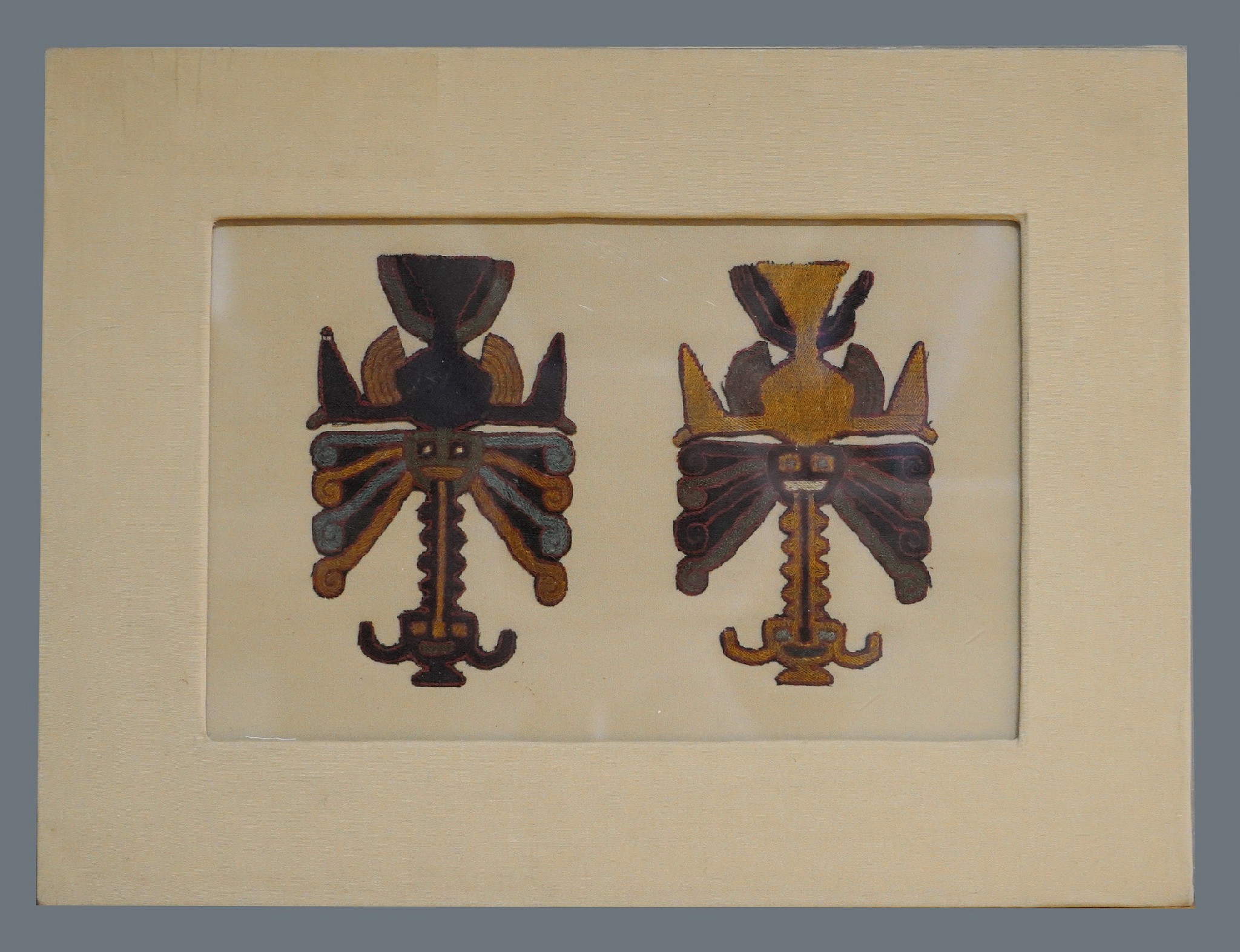






Peru, Paracas Embroidered Nightjar Birds
Paracas cross knit needle stitched embroideries are considered the finest in all antiquity. This pair of birds with outstretched wings are crafted in opposing colors inverse of one another, representing duality in nature. Each bird has a long proboscis with a trophy head at the end. This fragment belonged to an original larger mantle, which contained many birds arranged in alternating colors on a grid. This species of bird is possibly a Nightjar, also known as “goatsuckers.†Some Nightjars feature long feathers hanging down that look like a proboscis, and are identified in Pre-Columbian Art of South America, by Alan Lapiner in figure 206. These birds are also illustrated in Tejidos y Ponchos Indigenas de Sudamerica by Alfredo Taullard, 1949, plate 132 and in ALTPERUANISCHE KULTUREN Vol.1, pg.177. These embroidered nightjar birds have excellent provenance. Excellent color, professionally mounted in a Plexiglas frame. Acquired at Christie's Auctions in 2006, from an old estate.
Period: Peru, Paracas, Ocucaje Phase 8, South Coast, c. 700 - 200 BC
Period: Peru, Paracas, Late Phase, South Coast, c. 300 - 200 BC
Media: Textile
Dimensions: Mounted: 12" x 9" x Length 4 1/2" each
$15,000
M6076
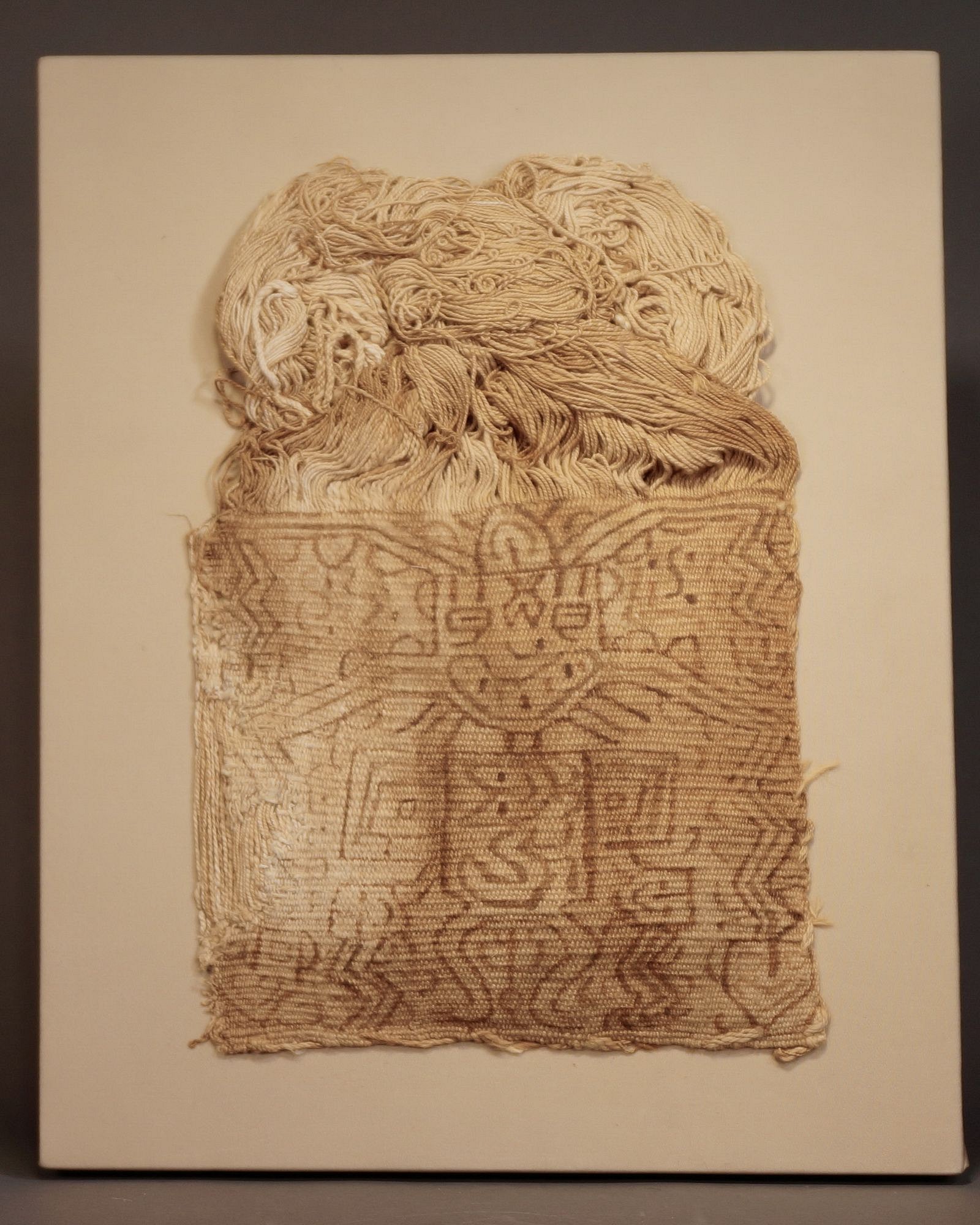
Peru, Paracas Painted Mummy Mask with Deity and Serpents
This woven mask is painted with an image of a front-facing deity flanked by serpents emanating from the deity’s head and mouth. This mask introduces several artistic innovations from the “Full Face†masks of Paracas Phase 9. The face is smaller, and the figure has a larger body, which makes the overall image less mask-like. The drawing is a good example of Horror Vacui, fear of empty the composition. Feline and trophy head elements fill the space around the main figure. A similar transition period mask is illustrated in Dawson's article PAINTED CLOTH MUMMY MASKS OF ICA, PERU, on pages 83-104 of Junius Bird Pre-Columbian Textile Conference in 1973. fig. 12.
Mounted on its original cotton backing. Some natural wear, exposed warps on the left side. The mask is complete with the original unspun cotton backing. Acquired by David Bernstein in 2007.
Period: Peru, Paracas, South Coast, c. 500 - 200 BC
Period: Peru, Paracas, South Coast, c. 500 - 200 BC
Media: Textile
Dimensions: Height:12.5" x Width: 8.25"
Mounted Height: 16" x Width 12"
$6,500
M7033H
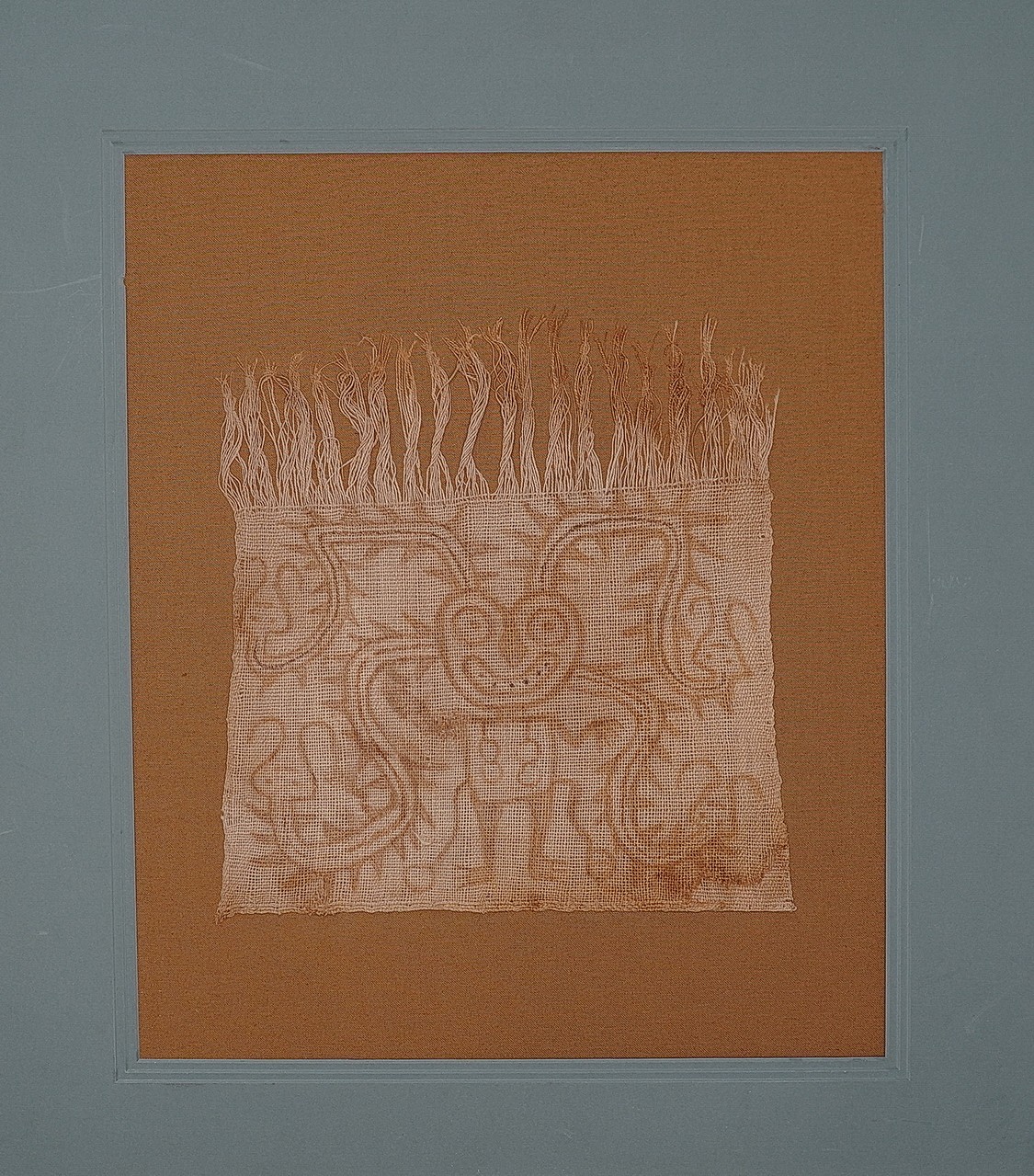


Peru, Paracas Painted Mummy Mask with Figure and 4 Serpents
This mummy mask has one serpent emerging from each side of the central feline Oculate Being's head. Two other serpents emerge from the top of the heart. The serpent heads could also be heads of marine eels are a unique feature not seen on many Paracas masks. The bodies are serrated, with thin spikes with a narrow line following the curve of their backs. The Oculate Being is shown as a figure rather than just a head and is depicted with curvilinear lines and an upturned mouth – indicative of the Paracas, c. 300 – 100 BC. There is also a short fringe on the top edge of the textile. Paracas funerary masks are discussed in L. Dawes' article PAINTED CLOTH MUMMY MASKS OF ICA, PERU, on pages 83-104 of Junius Bird Pre-Columbian Textile Conference in 1973. Formerly in the Louis Slavitz collection prior to 1970. Very good condition, mounted on an acid-free mat.
Period: Peru, Paracas, South Coast, c. 500 - 200 BC
Period: Peru, Paracas, South Coast, c. 500 - 200 BC
Media: Textile
$4,500
92004





Peru, Paracas Painted Mummy Mask with Reversible Face
Mummy masks are among the earliest textiles in the Paracas textile tradition. They were constructed of plain weave cotton panels with images painted on one side and long, unwoven warp threads issuing from the top. They are referred to as 'mummy masks' because they were tied onto the faces of the wrapped remains of individuals who formed the elite society of Paracas. These masks may have been intended to ward off evil spirits. The figure portrayed on the mask is referred to by Menzel, Rowe and Dawson, in 'The Paracas Pottery of Ica: A Study in Style and Time' (1969) as the Oculate Being. This feline deity, usually distinguished by facial characteristics such as large circular eyes and an upturned mouth, often with a protruding tongue. Bodiless faces like the image on this textile are a feature of earlier Paracas mummy masks. Later examples are painted with the deity's entire figure. In this mask, a central square depicting the face is surrounded by a brilliant red border. The concentric eyes are enclosed within a stepped diamond with curls extending above and below. The nose is formed by two conjoined trapezoids, one with nostrils and the other with two long vertical lines. According to Dawson's Seriation of Features of Cloth Mummy Masks (1973). Paracas funerary masks are discussed in the article PAINTED CLOTH MUMMY MASKS OF ICA, PERU, on pages 83-104 of The Junius Bird Pre-Columbian Textile Conference in 1973. Formerly in the Louis Slavitz collection prior to 1970. Mounted on an acid free mat.
Period: Peru, Paracas, Ocucaje Phase 9, Ica valley, South Coast, c. 300 - 200 BC
Period: Peru, Paracas, Ocucaje Phase 9, Ica valley, South Coast, c. 300 - 200 BC
Media: Textile
Dimensions: H. 18 x W. 11 1/4 in. including fringe
$8,700
92007
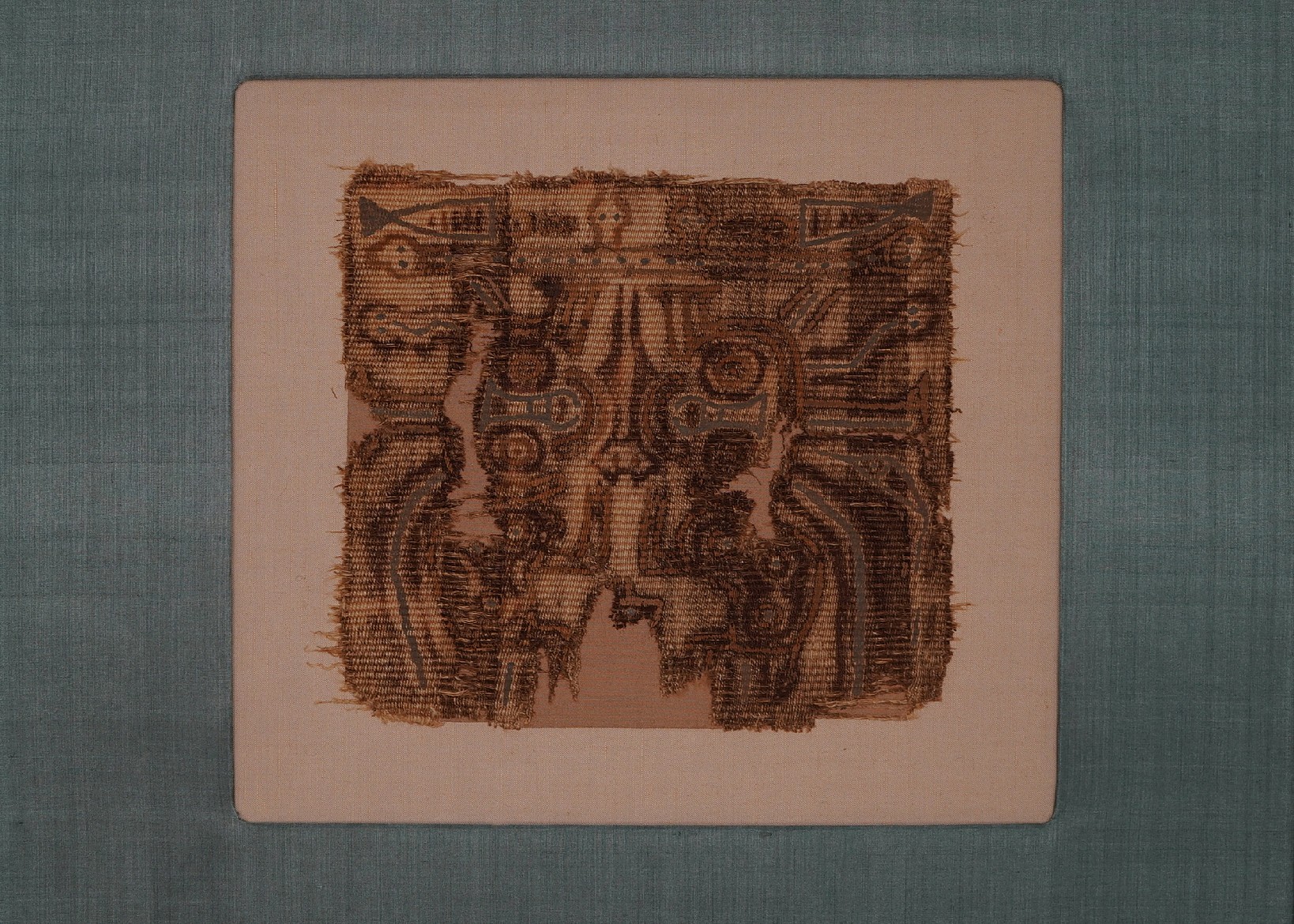


Peru, Paracas Painted Mummy Mask with Reversible Mirror Image
This wonderful painted mask can be viewed in two directions and displays fantastic compositional and design craftsmanship. The eyes are shared by two attendant profile felines with heads turned outwards and undulating serpents emanating from each head. A horizontal serpent lies above the main head. The clever symmetrical design integrates a variety of smaller animals which when combined, also form the larger central feline. Similar masks with the attendant felines are illustrated in Painted Cloth Mummy Masks of Ica, Peru by Lawrence Dawson, figures 2 & 5. Another unique feature is the unusually well preserved blue gray pigment highlighting the nose and serpents of each attendant figure. Acquired by David Bernstein in 1992. In good condition, professionally mounted on a covered mat board.
Period: Peru, Paracas, Middle Period, South Coast, c. 700 - 300 BC
Period: Peru, Paracas, Middle Period, South Coast, c. 700 - 300 BC
Media: Textile
Dimensions: Height: 8 ¾†x Length: 8â€
$4,700
92111
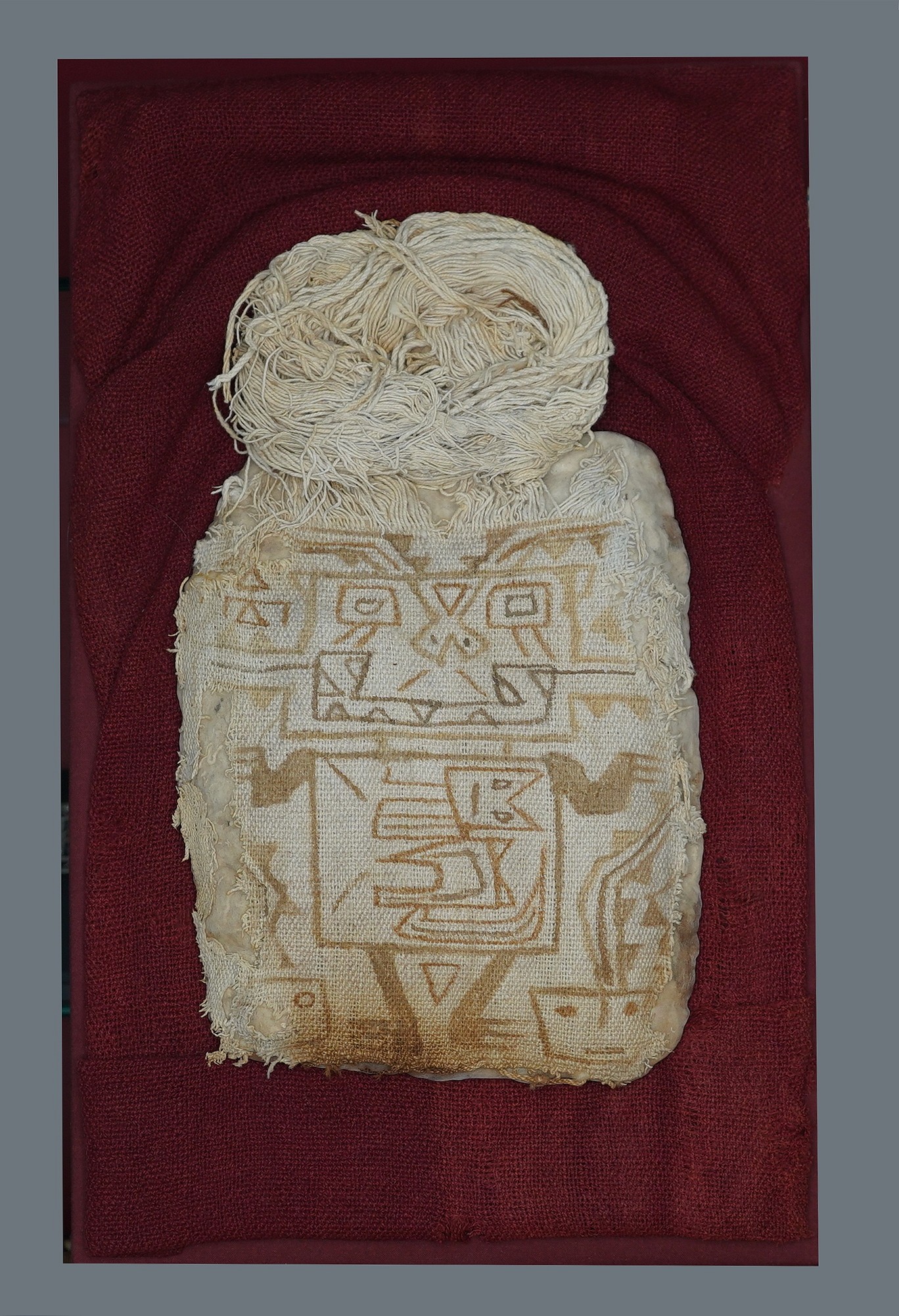


Peru, Paracas Painted Mummy Mask with Figure and Feline
This beautiful Paracas mummy mask is complete with its original ancient cotton and red wool backing and painted with natural pigments from the Andes. The painted figure has two serpents emanating from its mouth and a secondary creature nested inside the body, symbolizing shamanic transformation and rebirth. This example with a larger head on a body is a transition from the small head on the larger torso. Paracas funerary masks are discussed in the article PAINTED CLOTH MUMMY MASKS OF ICA, PERU on pages 83-104 of Junius Bird Pre-Columbian Textile Conference in 1973. Formerly in the Louis Slavitz collection prior to 1970.
Period: Peru, Paracas, Ocucaje Phase 9, Ica valley, South Coast, c. 300 - 200 BC
Period: Peru, Paracas, Ocucaje Phase 9, Ica valley, South Coast, c. 300 - 200 BC
Media: Textile
Dimensions: 19" x 12" including mounting and Plexiglas box.
$12,000
79004
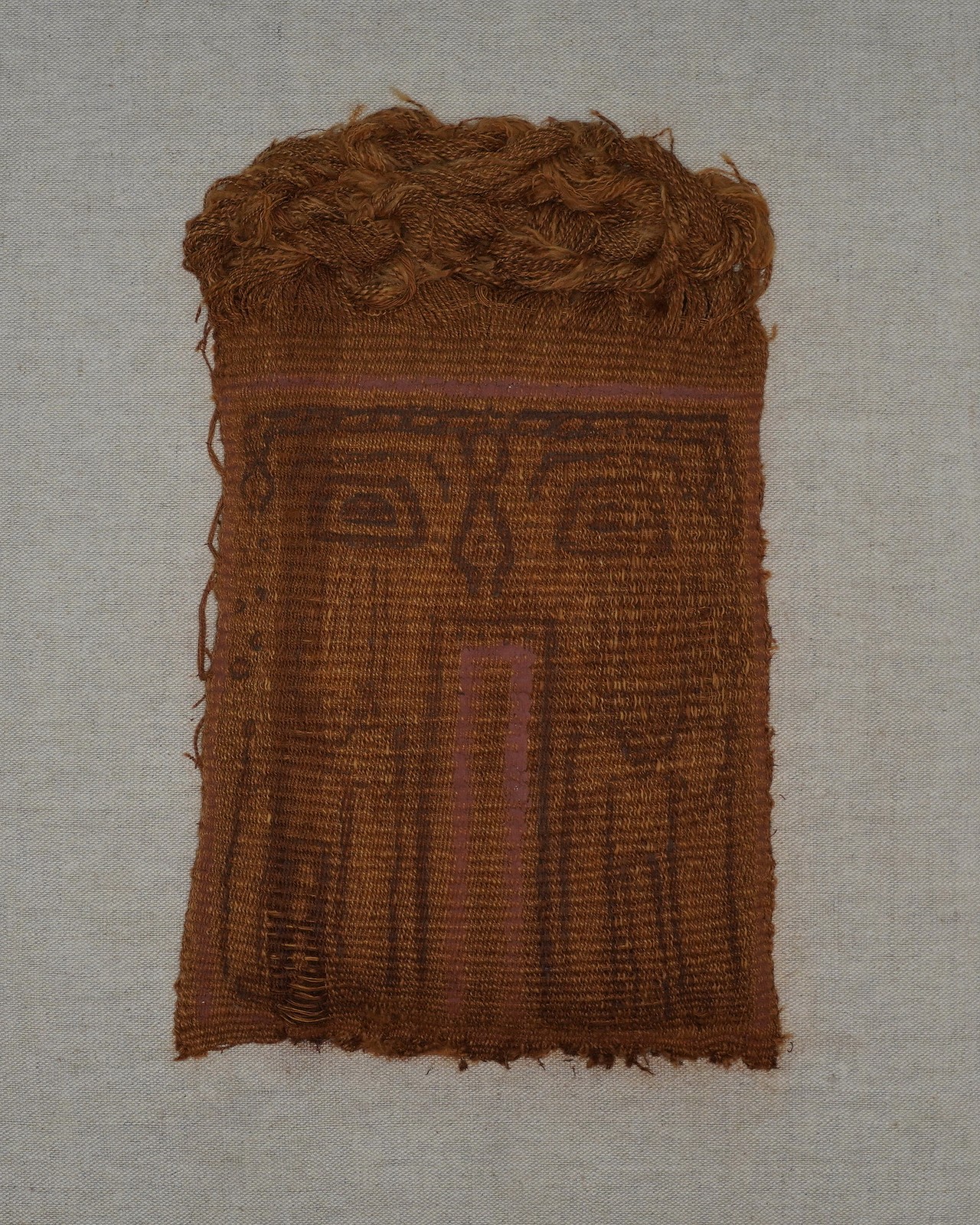


Peru, Paracas Painted Mummy Mask Depicting a Face Doubling as a Temple Entrance
This rare funerary mask has a double meaning and can be interpreted in two ways: at first glance it appears to the face of a deity with tears streaming down its cheek. On second glance, it is apparent that the rectangular mouth of the deity can also be interpreted as a grand entrance to a temple, a larger-than-life door flanked by two staff bearing guards. The scale of the guards relative to the size of the door paints a picture of an intimidating, awe-inspiring sensory experience that would have affected any individuals making a pilgrimage to the temple. Archaeologist Max Uhle discovered a similar mask with a square-eyed face that doubles as a temple entrance, two standing figures, and a straight headband; Uhle's mummy mask is illustrated in the book Painted Cloth Mummy Mask of Ica, Peru, By Lawrence Dawson, in figure 7. This mask is in better condition than the one illustrated in Dawson's book and has retained more of the original pigment colors over time. Acquired by David Bernstein in 2003.
Period: Peru, Paracas, Ocucaje Phase 9, Ica valley, South Coast, c. 300 - 200 BC
Period: Peru, Paracas, Ocucaje Phase 9, Ica valley, South Coast, c. 300 - 200 BC
Media: Textile
Dimensions: Height 11" x Width 8 3/4"
$16,000
M3004
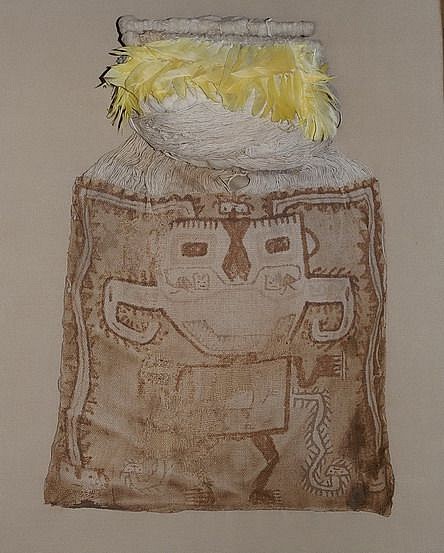


Peru, Paracas Painted Mummy Mask with Original Yellow Macaw Feathers
This is a large, complete mummy bundle mask with its original unspun cotton backing and loom ornament, embellished with yellow feathers. The frontal figure is painted with reddish brown pigment features a large head and smaller body, indicative of the Ocucaje 9 historical period. The main figure is surrounded on both sides by a serpent studded with conical spikes emanating from the head. This dentated serpent is a recognizable theme Andean art. Two small felines with their tails connect under the nose, forming a mustache. The exaggerated ears are also surrounded by spikes. It is complete with the original backing material and the loom stick. This maks is illusrated in Ancient Peruvian Textiles by Ferdinand Anton, 1984, fig.11, and is also featured in Brucken in die Sukunft, published by Deutsche Bank in 1992, page 2.
Small rips and tears. Professionally conserved and mounted on a stretcher. Was in the collection of Mrs. Marion Anton-Kock prior to 1970.
Period: Peru, Paracas, Ocucaje South Coast, c. 300 - 200 BC
Period: Peru, Paracas, Ocucaje South Coast, c. 300 - 200 BC
Media: Textile
Dimensions: Unmounted: H.16" x W.12"
Mounted: H.20.5" x W.16"
$22,500
M5003
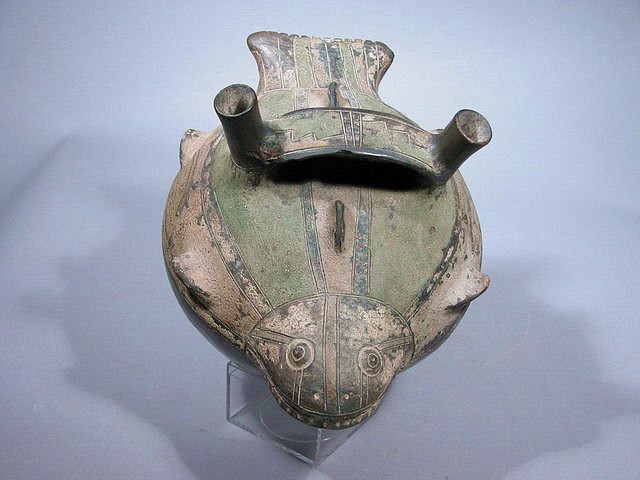




Peru, Effigy Vessel of a Patagonian Toothfish with Resin Pigment
This bridge-spout vessel depicts a toothfish decorated with longitudinal bands of buff and green pigment. The protruding head and fins resemble the Patagonian toothfish, popularly known as the Chilean sea bass. These fish were caught with a hook and line in ancient Pre-Columbia and are still caught this way in modern times. The Patagoninan toothfish, (Dissostichus eleginoides) has a long life span and is thought to live up to 50 years. The average toothfish weighs between 15 and 20 pounds, however they can grow as large as 220 pounds. The flaring spouts indicate that the ceramic was crafted in the Paracas Necropolis style, as opposed to the more common Cavernas style, which features blind bridge spouts. The harmonic balance between naturalism and abstraction is a unique stylistic trait in Andean art that attracted cubist and minimalist artists such as Pablo Picasso and Henry Moore to ancient Andean art. These famous artists were intrigued by Andean art and wanted to replicate this method of combining abstract forms and narrative imagery in their own paintings and sculpture. Alan Sawyer discusses the Necropolis style in his book Ancient Peruvian Ceramics: The Nathan Cummings collection on pages 96-97, fig. 135-138. The only other known Paracas toothfish vessel is in the Museum of the University Agraria, Lima, Peru. Acquired from the estate of British collector. London, prior to 1996.
Period: Peru, Paracas, South Coast, c. 500 - 200 BC
Period: Peru, Paracas, South Coast, c. 500 - 200 BC
Media: Ceramic
Dimensions: Height: 6 1/2" (14.2 cm.) X Length: 8" (18 cm.)
$35,000
96044
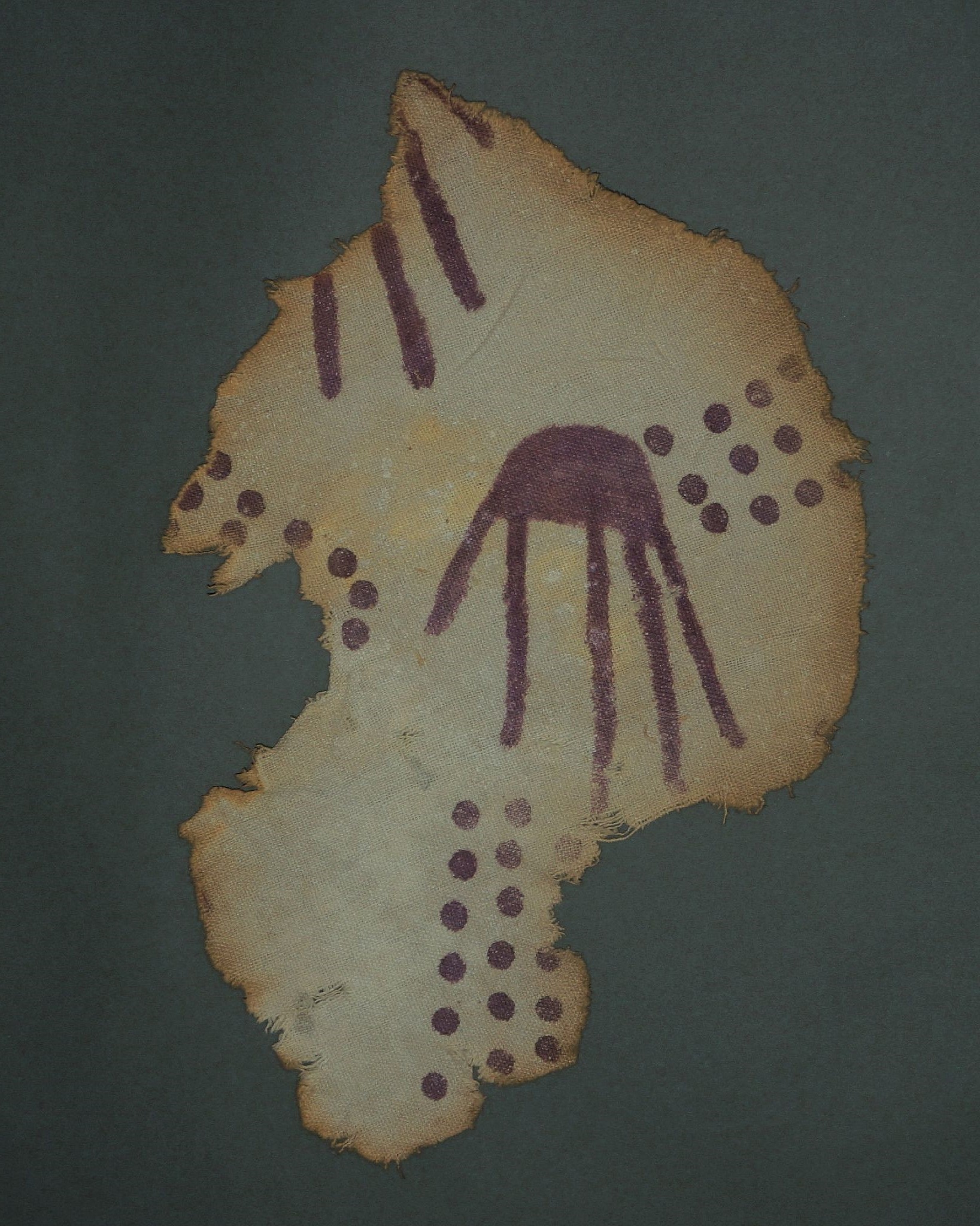



Peru, Paracas Painted Cloth Fragment with Purple Jellyfish
The jellyfish with its eggs is an iconic image from the Paracas period. The purple pigment was made from the secretion of the murex, a bivalve that lives on the rocky coast of Southern Peru. The murex's yellow secretion turns an intense reddish-purple when it touches cotton. The Paracas weavers were the only Peruvian craftsmen that used the murex dye, from the 3rd to 1st century BC. Close inspection reveals traces of other pigments that have disappeared over time, evidence of a more complicated decorative scheme. This murex bivavle also lives in the Mediterranean, and the same dye, known as Tyrian purple, was favored by the Greeks.Murex dyed weavings have also been found in excavations in Israel dating c.1900 BC according to the Oct 21, 2022 edition of Times of Israel. Acquired by David Bernstein in 2016.
Period: Peru, Paracas-Late phase, Ocucaje-South Coast, c. 300 - 100 BC
Period: Peru, Paracas-Late phase, Ocucaje-South Coast, c. 300 - 100 BC
Media: Textile
Dimensions: Length: 16 1/8" X 9 3/8"
$5,500
n6069
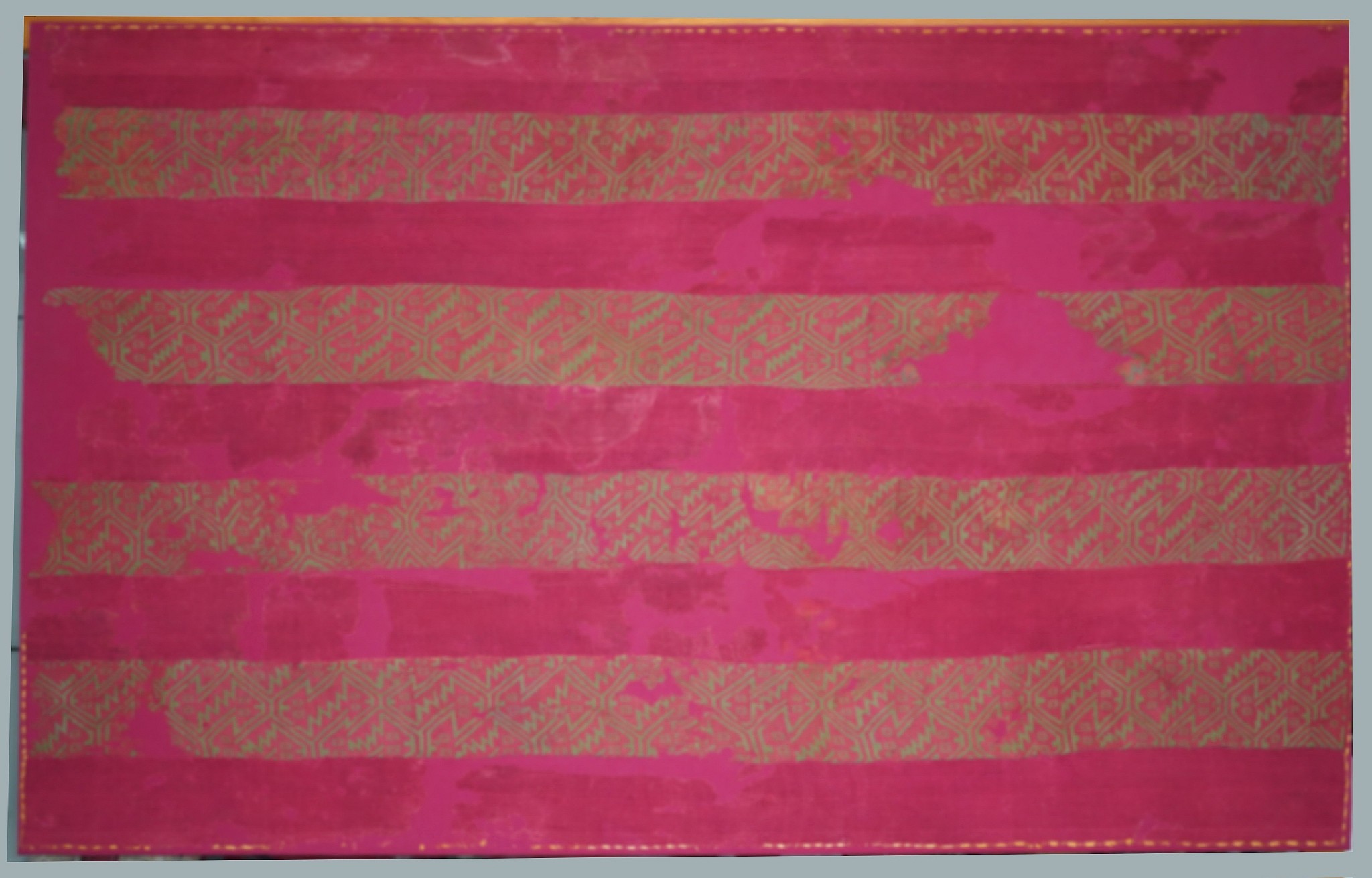


Peru, Early Paracas Double-Cloth Mantle with Bands of Interlocking Serpents on Strawberry Ground
This beautiful woven textile features lime green bands of interlocking geometric double-headed snakes on a red ground. The interlocking serpent motif is one of the oldest motifs in the Andes, dating prior to 1,500 BC. Snakes were an important part of Andean mythology; they emerge following a rain and are often portrayed in Pre-Columbian art together with imagery of water, rainbows, and energy. Double-headed snakes do exist in nature, although they are extremely rare, and it is likely that they were considered a powerful omen of abundance in Paracas animist cosmology. The double-headed snakes portrayed here also feature lightning strike designs on their torsos, which convey a sense of energy, motion, and power.
The contrasting combination of bright red and lime green fields create an optical illusion that the snakes are vibrating. These two carefully chosen hues of red and green are at opposite ends of the visual spectrum that the human eye can see, causing the brain to become overloaded, which translates into a sense of vibration. The Paracas’ knowledge of color with many of the great abstract color theorist artists of the 20th Century such as Albers, Malevich, and Kandinsky. Ancient works of art with abstract beauty such as this were highly sought after during the golden age of collecting in the Mid-20th century by wealthy collectors as well as artists such as Matisse and Picasso.
The mantle bands were woven using a complicated technique called double cloth in which the front side motifs are in opposite colors from the rear. This same motif appears in the frontispiece in Bird and Bellinger's catalog raisonne Paracas Textiles. Professionally restored and mounted on a stretcher. Acquired by David Bernstein in 2000.
Period: Peru, Paracas, South Coast Early Intermediate Period, Phase II, c. AD 100 - 200
Period: Peru, Paracas, South Coast Early Intermediate Period, Phase II, c. AD 100 - 200
Media: Textile
Dimensions: Length: 63 in. x Width: 39 in.
$38,000
MM318
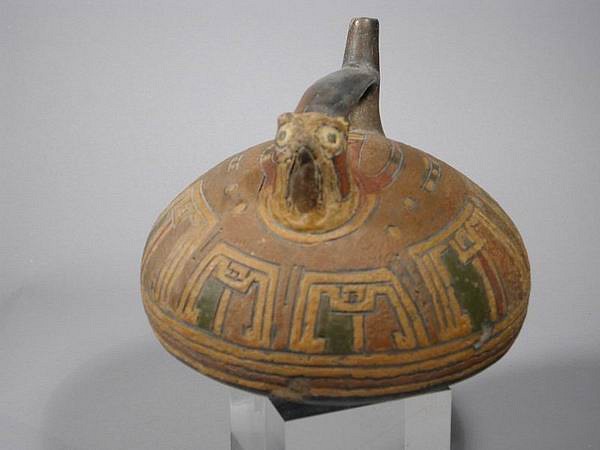
Peru, Paracas Ocucaje Bridge Spout Vessel
This Paracas vessel has one blind spout modeled in the form of a falcon’s head with feline ears. The compressed, ovoid body was decorated with a resin-painted and incised bird directly below the bridge spout handle. The chamber was enhanced with a series of squarish "U" shapes, accented with a single Chavinoid eye in profile. The circumference is decorated with blocks of dark olive green and yellow ochre. These geometric configurations resemble abstract bird forms, the style of which is consistent the Paracas Phase 8 ceramic style. The use of resin painted designs outlined by incisions, referred to as "zoned" design, can also be assigned to Phase 8. Literature and illustrations of the various phases of Paracas style ceramics are provided in Menzel, Rowe and Dawson, "The Paracas Pottery of Ica: A Study in Style and Time" (1969). Acquired from Auction in 2016 from an old estate.
Period: Peru, Paracas, Ocucaje Phase 8, South Coast, c. 700 - 200 BC
Period: Peru, Paracas, Ocucaje Phase 8, South Coast, c. 700 - 200 BC
Media: Ceramic
Dimensions: Height: 5 1/2 " x Diameter: 5 1/2"
$4,000
98137B






Peru, Paracas Necropolis Embroidered Corner Border with Eight Large Feline Figures and 100 Secondary Figures
This symbolically rich Linear style Paracas mantle border features a group of magnificent animal deities, ranging from ferocious to benevolent. The eight main deities are feline Oculate Beings with exaggerated eyes, alternating in orientation, each with a tongue terminating in a serpent's head. Oculate Beings in Andean art often resemble the Pampas cat, Leopardus pajeros - a distinctive species of wild cat with unusually large eyes found along the Pacific coast of South America. Inside each of the Oculate Beings' torso is a double-headed condor, and a variety of small, colorful, attendant felines are embroidered around the perimeter of the design.
The Oculate Being with a smaller animal nested inside of it is a classic Andean shamanic trope that signifies death, rebirth, and transformation. Rather than representing the literal birth of an individual animal, these chimeric creatures, skeletal in form, nested inside the abdomens of the larger Oculate Beings represent a mythical cosmology of reverence rebirth and transformation.
The Paracas cosmology is also present in the abstract structure of the composition, which suggests the ambiguous boundaries between the earthly realm and the spiritual world. South American shamans are known to fast and chant in preparation for a voyage into the spiritual world. The lack of perspective and the absence of recognizable landscape features in the design of this textile signifies an intermediary zone outside the normal bounds of space and time, accessible only to shamans and spirit animals who can traverse the boundaries between worlds.
Red and pink threads of extremely similar hue were intentionally selected by the Paracas artisans to create an optical illusion that causes the smaller figures to appear to be emerging from the composition over time. This type of optical illusion using color only to create the sensation of forms emerging over time was also used in the abstract paintings of Modernist Ad Reinhardt.
Expert knowledge of color theory was used to select perfectly contrasting colors, creating an optical illusion in which some of the deities appear to vibrate, while others appear to merge into a unifying field of color. With prolonged observation, the scene in the textile appears to oscillate, and the deities appear to be moving. The changing imagery and perceptual illusion of motion created through use of compositional elements alone shares qualities with paintings of some of the greatest early 20th Century Modernists, including painter Wassily Kandinsky.
Kandinsky believed that each color had a spiritual vibrational property aside from its’ electromagnetic wavelength, and that colors could profoundly affect the human spirit. Kandinsky wrote about these concepts in his 1911 treatise, Concerning the Spiritual in Art. Also see Anne Paul's PARACAS RITUAL ATTIRE: Symbols of Authority in Ancient Peru, University of Oklahoma Press, 1990. p. 170. Professionally conserved and pressure mounted in a Plexiglas frame. Acquired by David Bernstein in 2003.
Period: Peru, Paracas, Ocucaje-South Coast , 300 - 200 BC
Period: Peru, Paracas, Ocucaje-South Coast , 300 - 200 BC
Media: Textile
Dimensions: Length 45" x Width 9 3/4"
Price Upon Request
M4003
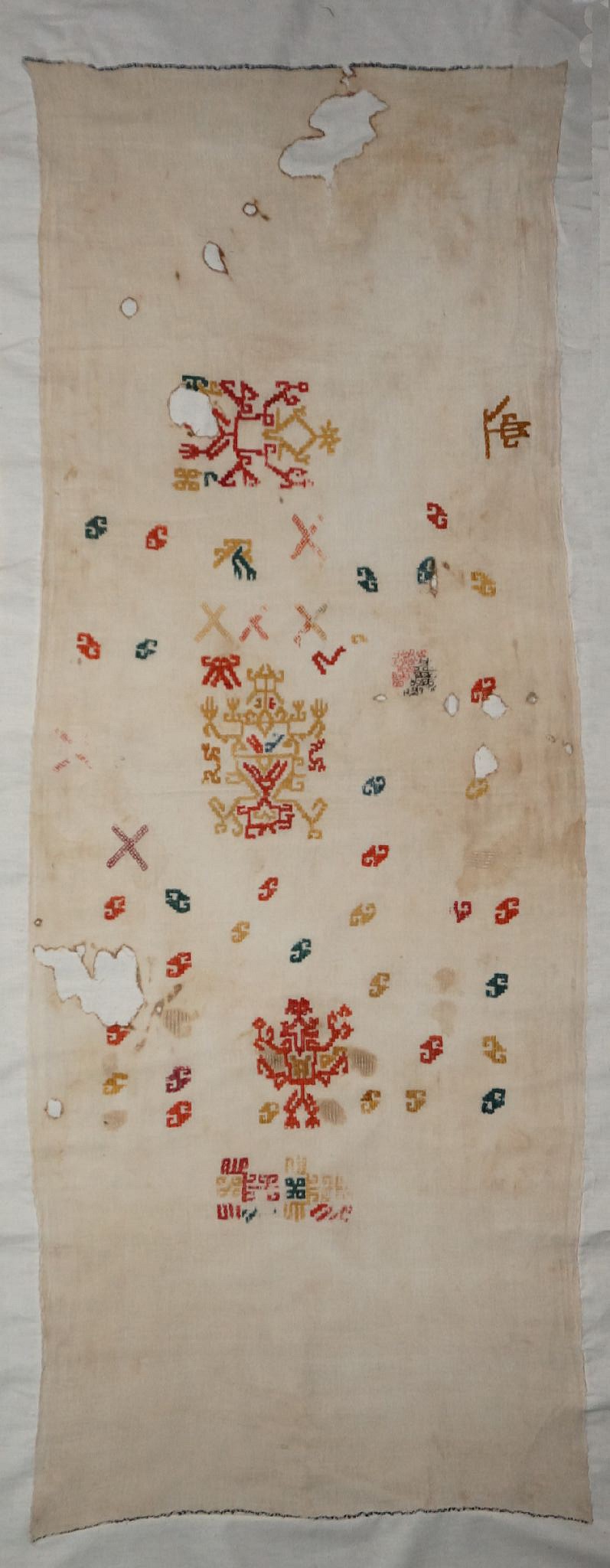



Peru, Proto-Nazca "Cabildo" Sampler with Three Figures in Gold and Red
This sampler is embroidered with abstract creatures with their hands held upwards. The sampler is embroidered with camelid dyed fiber in red, green and gold on a fine woven white cotton ground. The two figures at opposite ends have arms and legs with fancy appendages at the waist and an abstract face on top of each head. Samplers were used by the Paracas and Early Nasca to plan out designs for large textiles. The central figure appeas to be a shaman with a large head wearing a crown with three appendages on each side embroidered in gold. Nested inside the central figure is secondary figure embroidered in red, depicted upside down as if it is falling. The sampler is embellished with 42 individual connected step-volute patterns in red, green, gold and brown. In addition, there are five X's interspersed in the design. The panel is complete, in good condition, with all sides selvaged, and professionally lined. There are 3 small holes and 7 very small holes. Similar samplers are discussed and illustrated in "Early Nazca Needlework" by Alan Sawyer.
Period: Peru, Paracas, Ocucaje-South Coast , 300 - 200 BC
Period: Peru, Cabildo, South Coast, c. AD100 - 200
Media: Textile
Dimensions: Length: 63" x Width: 22"
$6,500
93129
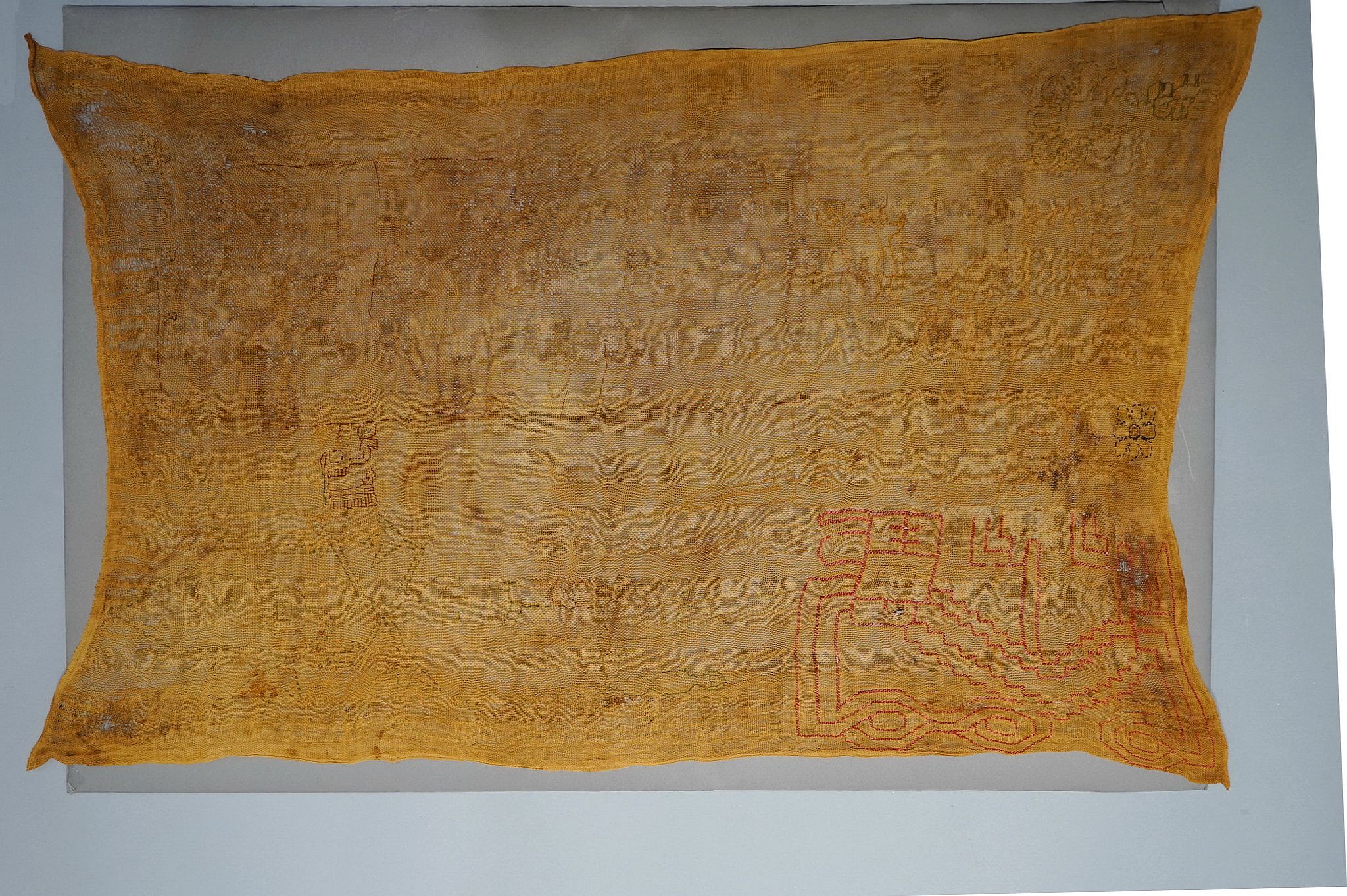








Peru, Proto-Nasca Sampler with Ten Unfinished Images
This intact sampler from the Cabildo site in the upper section of the Rio Grande de Nasca is described by Alan Sawyer in his book EARLY NASCA NEEDLEWORK, published in 1997. The woven backing cloth is complete, but the embroidered figures are still in progress and include partially finished figures and one red serpent. This textile shows how the Nasca craftsmen painted the imagery on the textile first, then outlined each figure with thread, and finally embroidered the imagery. The finished sampler would be double-embroidered with multiple colors and a lexicon of mythological characters and symbols. The book is an excellent reference for study of the richness and complexity of early Nasca imagery. This is a very rare example, as most are in the permanent collections of major museums, including the Art Institute of Chicago, the Metropolitan Museum of Art, New York, and the Textile Museum in Washington D.C. Ex. collection of Nobuko Kajitani, former chief textile conservator at the Metropolitan Museum of Art, prior to 1975.
Period: Peru, Nasca, Proto Phase, South Coast, c. 100 BC - AD 200
Period: Peru, Nasca, Proto Phase, South Coast Calbildo in the Rio de Grande de Nasca, c. 100 BC - AD 200
Media: Textile
Dimensions: Width: 32" x Height: 18"
$11,500
89100
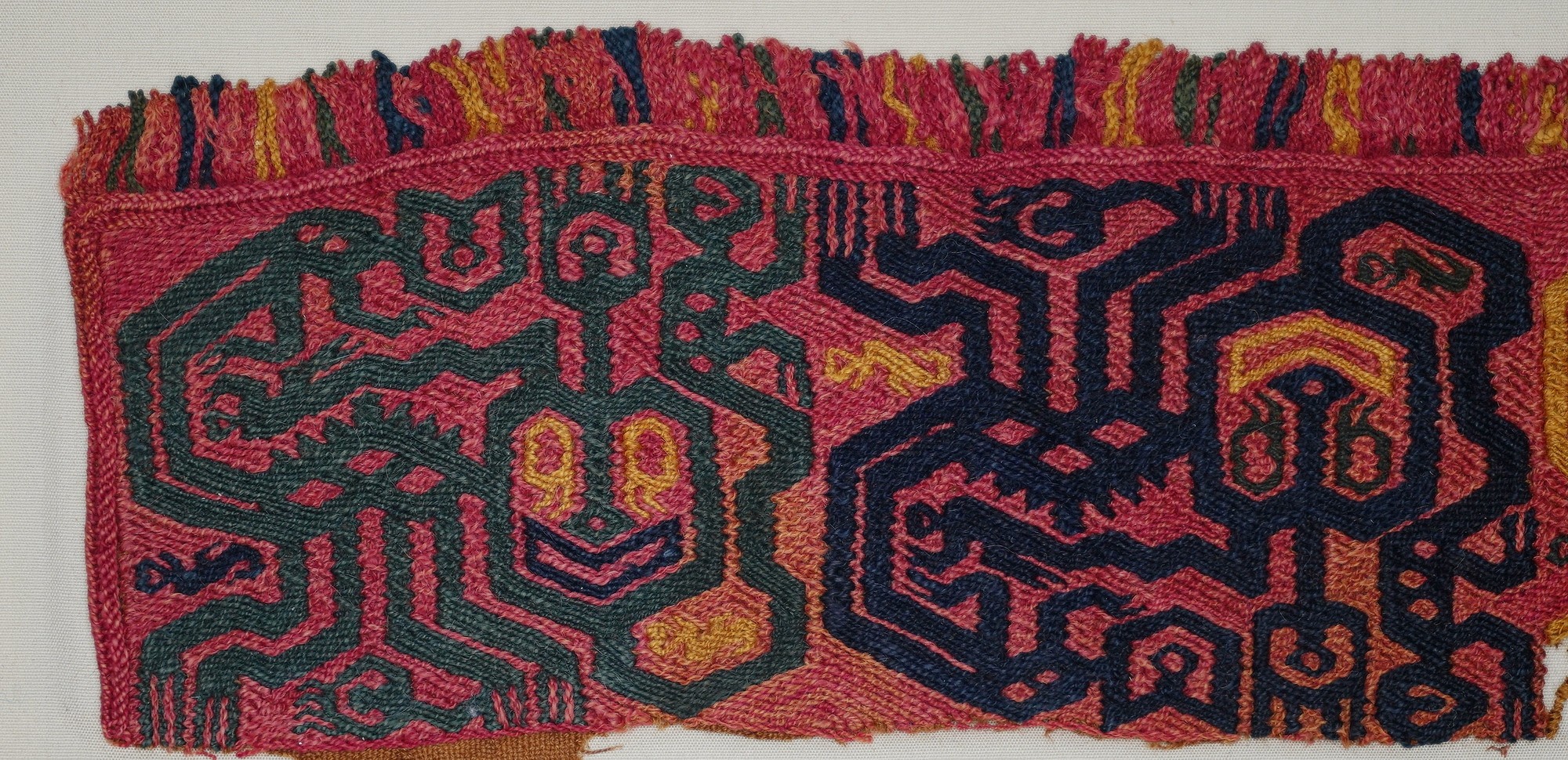
Peru, Paracas Border Section with Three Colorful Felines on Red Gound
Paracas textiles served as a medium of communication between the realms of the living and the dead. This Linear style border section features three embroidered feline figures in alternating colors and positions. One edge has its original fringe intact. The feline figures represent the "Oculate Being," a prevalent theme occurring throughout the Paracas period. Here the feline motif is presented with an oversized, characteristically heart-shaped head with a wide smiling mouth and hexagonal eyes. Another geometricized form springs from the center of each of the feline heads. Long slender appendages forming the legs of the creatures end in forked claws or transform into smaller feline creatures. The plain weave red background and embroidered Oculate Being motifs are woven in green, blue, and yellow, creating a beautifully vivid contrast. This style is characteristic of the textiles that were found at the Necropolis at Wari Kayan. This textile is from the Early Horizon, Epoch 10. It is also illustrated in ANCIENT PERUVIAN TEXTILES by Ferdinand Anton, London, 1984, fig. 47. Ferdinand Anton collection prior to 1980. Good color and pressure mounted in a frame.
Period: Peru, Late Paracas, South Coast, c. 300 - 200 BC
Period: Peru, Late Paracas, South Coast, c. 300 - 200 BC
Media: Textile
Dimensions: Height: 3" x Length: 12"
Price Upon Request
92016
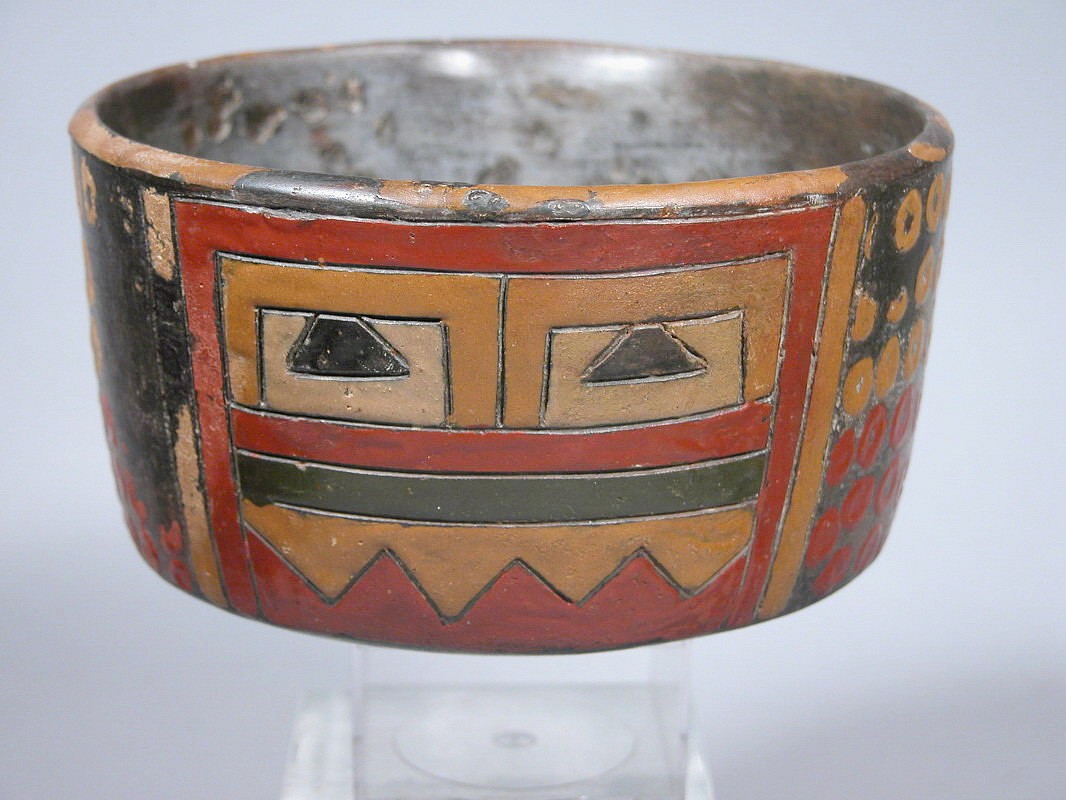

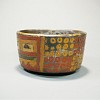


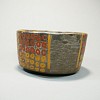
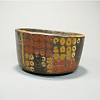
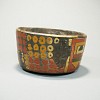


Peru, Paracas Polychrome Bowl with Incised Mask Design
This Paracas bowl was decorated with an abstracted geometric mask painted in rich post-fire pigments of red, ochre, olive green, and buff. The bowl also features geometric checkerboard patterns to the left and right of the face. There is a slight lip on the upper rim for pouring or drinking ritual libations. Abstract geometric vessels such as this were highly sought after by European and American painters during the heyday of the Modernist movement in the early and Mid-20th Century. A similar example is on display at the Metropolitan Museum of Art in New York and is illustrated in Alan Sawyer's, "Ancient Peruvian Ceramics," 1966, on page 74. This vessel has excellent provenance. It was acquired prior to 1970 and was loaned by the Landmann family of Westchester, NY, to the American Museum of Natural History in New York, where it was on view from 1984 to 1994.
Period: Peru, Paracas, Late Phase, South Coast, c. 300 - 200 BC
Period: Peru, Paracas, Late Phase, South Coast, c. 300 - 200 BC
Media: Ceramic
Dimensions: Height 3.14" Diameter 5.3/4"
$16,500
94081
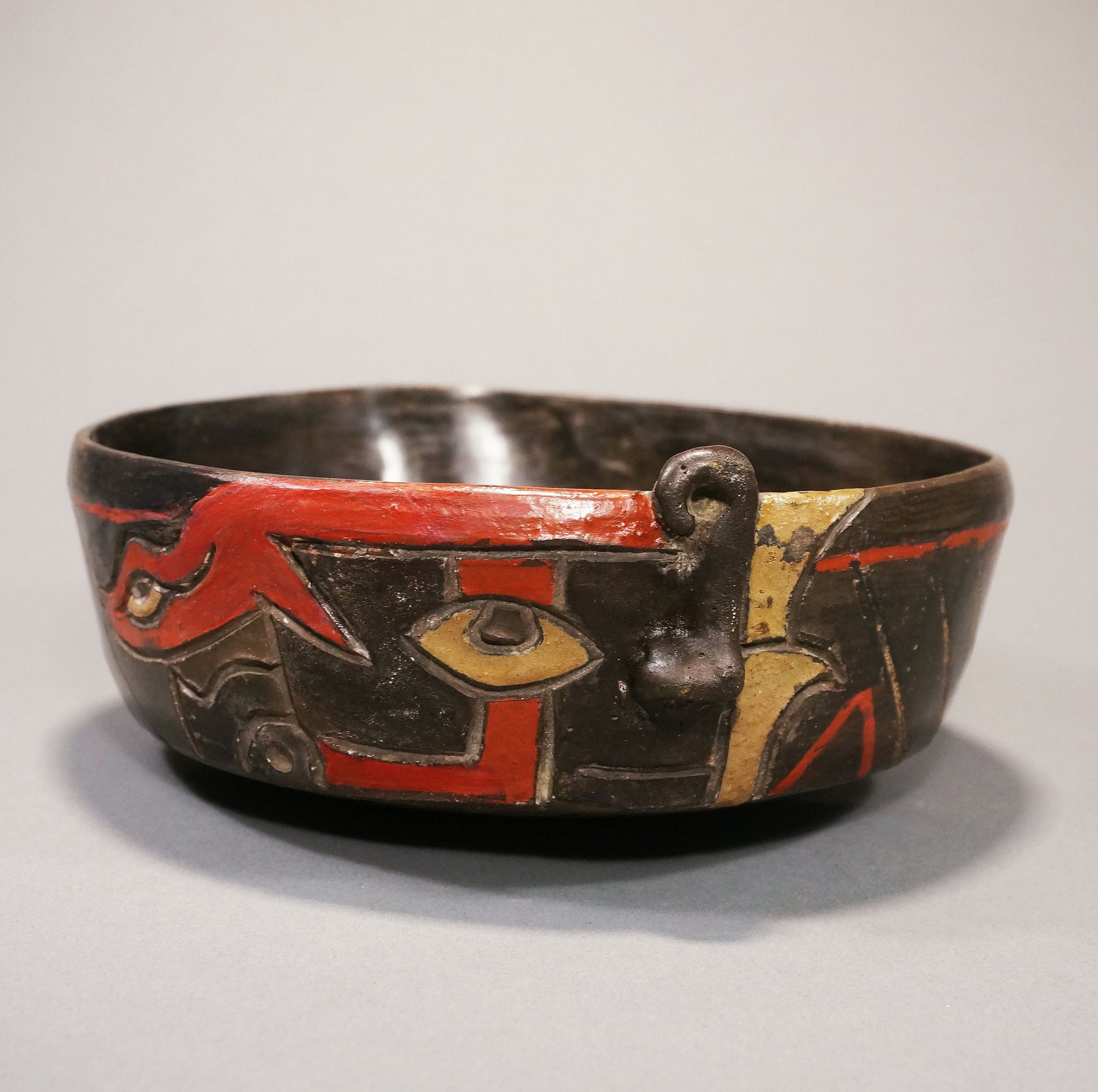




Peru, Early Chavin/Paracas Bowl with Transforming Cubist Face
This bowl demonstrates a human face with a distinct eye looking outward, transforming into the face of a feline entity. The red serpent above the eye suggests the presence of a supernatural demon or perhaps a knowledgeable serpent spirit guide offering wisdom. The incised designs are painted with polychrome resin pigments and has an extended lip on the rear upper edge, which was used to pour ritual libations - perhaps Ayahuasca or a similar psychedelic brew containing DMT from entheogenic plants found in the region. This bowl is also an excellent example of the geometric abstract style with bold blocks of color favored by the Paracas. It shares stylistic traits with the modern Surrealist and Cubist movements, featuring a morphing of narrative portraiture and purely abstract form. Ancient art objects with abstract and surrealist qualities were highly sought after by sophisticated collectors with excellent taste during the mid-20th Century. These collectors would combine ancient and modern artworks together, forming a unified gestalt aesthetic. Abstraction is quite rare among pre-modern societies, and one hypothesis as to why the Andeans had such a sophisticated understanding of abstract form and color is the entheogen theory. In his 2005 paper Psychoactive botanicals in ritual, religion and shamanism, Glenn H. Shepard discusses how Chavin de Huantar, the main Chavin temple, was located near a geologic unstable valley region in the Andes with a wealth of natural plant entheogens where two rivers merge. The Chavin people believed that the spirit could transcend the body and fuse with the spirit of the jaguar, a belief that was likely facilitated by entheogen use. This animistic belief system affected all subsequent Andean cultures, including the Paracas, whose would continue this belief. This bowl depicts a human face with a distinct eye, transforming into a jaguar spirit with a bright red serpent framing the eye. The red serpent suggests the presence of a sentient serpent demon or perhaps a knowledgeable spirit guide offering wisdom.
A very similar vessel is in the Oscar Landmann collection #119, Sao Paulo, Brazil. Ex-Collection Anton Roeckl, Germany.
Note: The bowl was painted within the incised designs with post-fired polychrome resin pigments and finished after firing with a second firing to melt the resin creating a glossy finish. This tradition began with the Chavin cult, a psychedelic cult that engaged in ritualistic jaguar worship. Using psychedelics, one could transcend the body and become the spirit of the feline. The Chavin influenced all subsequent Pre-Columbian cultures, including the Paracas, who would continue this belief. This bowl demonstrates a human face with a distinct eye looking outward, transforming into the face of a feline entity. The red serpent above the eye suggests the presents of a supernatural demon or perhaps a knowledgeable serpent spirit guide offering wisdom to the transforming shaman. This design demonstrates an animist belief in an interconnected network of souls and spirits.
Period: Peru, Paracas, Ocucaje, c. 500 BC - AD 100
Period: Peru, Paracas, Ocucaje, c. 500BC - 100AD BC
Media: Ceramic
Dimensions: Height: 2 1/2" x Diameter: 7"
$22,500
M7134
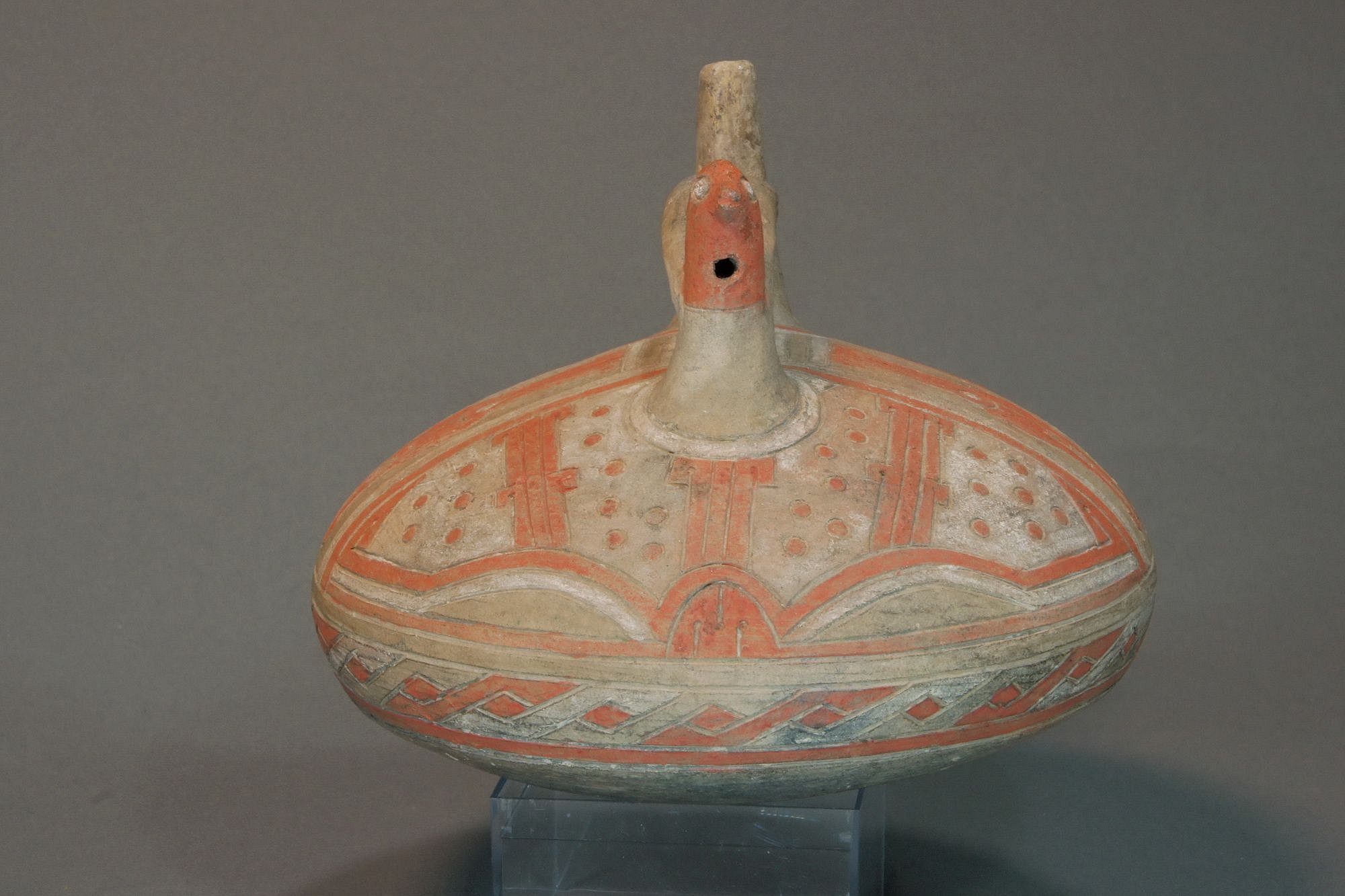








Peru, Paracas Late Phase 7 Ceramic Bridge-Spout Vessel with Hawk Head and Incised Feline Face
Paracas Iconography has been described in detail in THE PARACAS POTTERY OF ICA: A Study in Style and Time, by D. Menzel, J. Rowe and L. Dawson, U.C Press Berkley, 1964, pages 75 - 100. The hawk 's head is at the top of the blind spout, with its wings incised on the body of the vessel. The feline face on the front of the vessel has a distinct nose with 3 vertical lines representing its nostrils, each ending in small holes. These features, along with the slender arching eyes and brow terminating with a closed triangle and an incised circle around the base of the spout indicate that this is a Paracas Phase 7 vessel. See pages 232 and 325 of The Paracas Pottery of the Ica for similar illustrated vessels. The incised lines are filled in with cinnabar pigment. From the estate of Dr. Ernst Barash, prior to 1969. Acquired by David Bernstein in 2014.
Period: Peru, Paracas, Upper Callango Basin, Phase 8, South Coast, c. 700 - 200 BC
Period: Peru, Paracas, Upper Callango basin phase 6, South Coast, c. 700 - 200 BC
Dimensions: Height: 4" x Diameter: 5"
$8,500
n4046
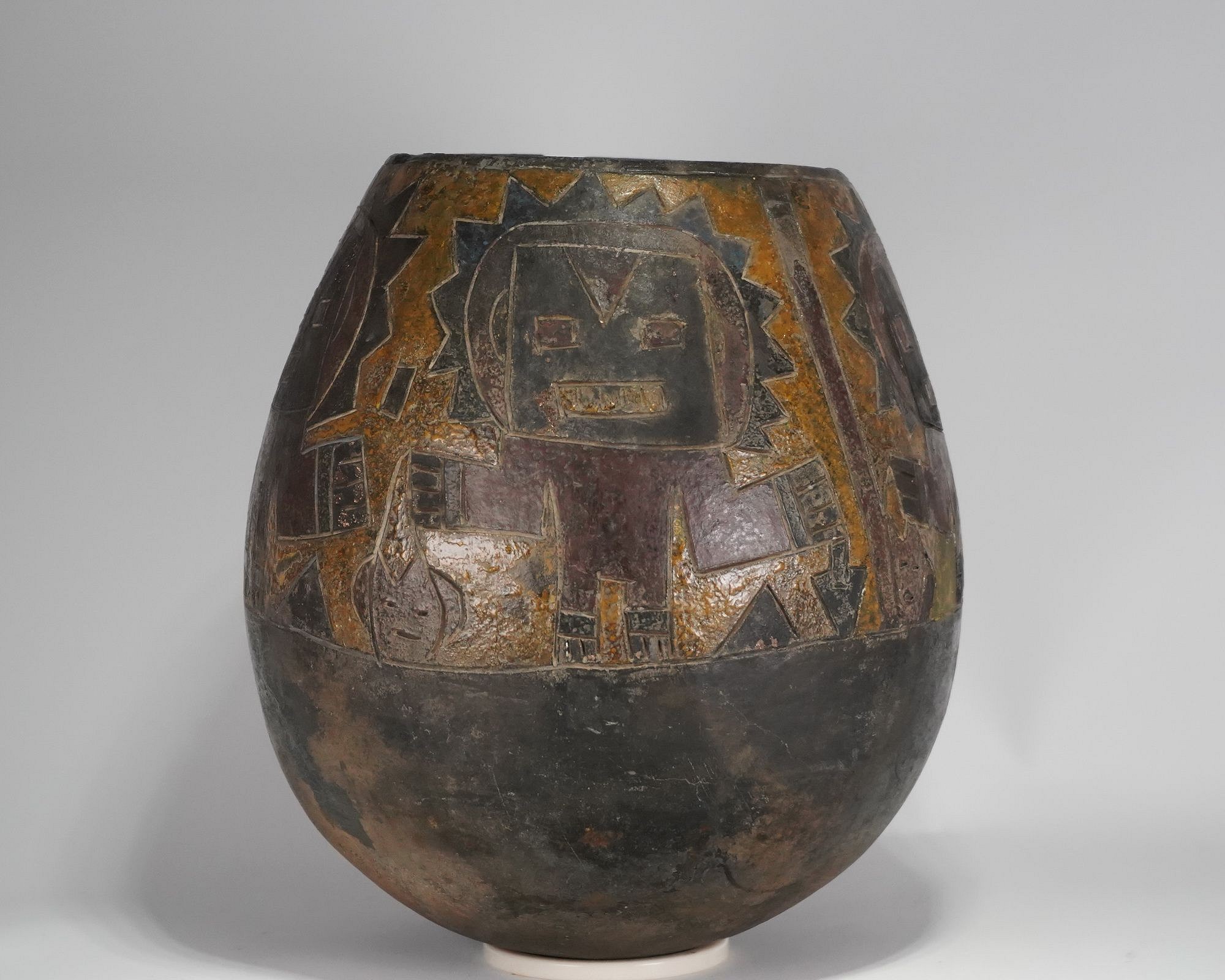





Peru, Paracas Style Ceramic Ovoid Urn
This beautiful ceramic funerary urn features four warriors, crafted with both lines and color applied to the surface with resin painting. Each shamanic warrior holds a trophy head, and one warrior also holds an obsidian pointed knife. The post fire resin painting features copper hued reds and browns, marron, yellow ochre, and dark blue. These large ovoid urns are rare, unique to a small 150 km area between the Pisco River and the Ica River, circa 200 to 100 BC. The shape and the drawing of the figures' facial features indicates that the urn is likely from the Late Paracas Period, Paracas Phases 9 and 10. A similar vessel from the same region in the collection of the National Museum of the American Indian is illustrated in Indian Art in South America, by Frederick Dockstader on page 100 and in PAINTED CLOTH MUMMY MASKS OF ICA, PERU,fig. 21.
Cracks restored especially to the lower section. There are large areas of loss of the original pigment.
Acquired by David Bernstein in 2012.
Period: Peru, Paracas, Ocucaje Phase 9, Ica valley, South Coast, c. 300 - 200 BC
Period: Peru, Paracas, Ocucaje Phase 8, Ica valley, South Coast, c. 300 - 200 BC
Media: Ceramic
Dimensions: Height: 11" x Diameter: 9 1/2"
$18,500
n2112
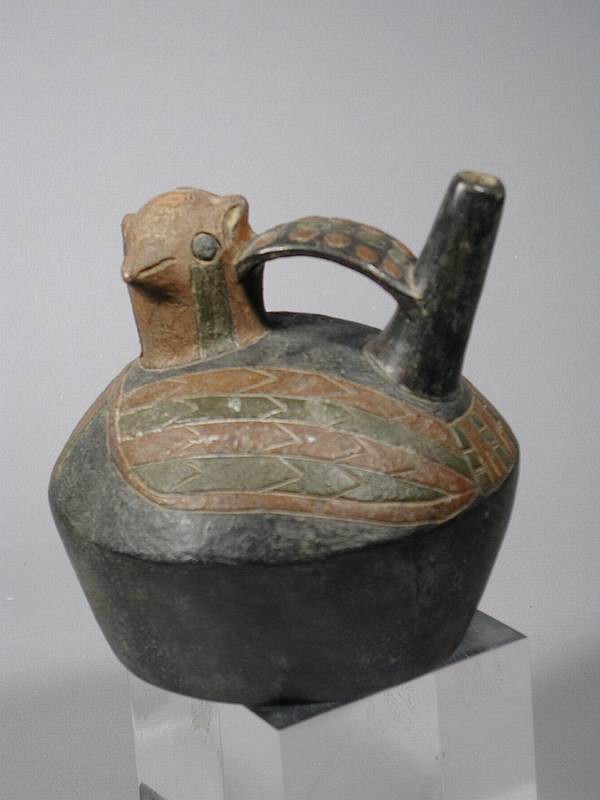





Peru, Paracas Falcon Effigy Vessel
This Paracas vessel has a blind-spout in the form of a falcon with pointed ears. The compressed, ovoid-shaped body was decorated with resin, painted, and incised, directly below the bridge spout handle. The chamber was enhanced with a series of squarish "U" shapes, accented with a central red stripe flanked by blocks of dark olive green and yellow ochre. These geometric configurations could be interpreted as highly abstracted bird forms and their presence is consistent within the development of the Phase 8 ceramic style. The use of resin painted designs outlined by incisions, referred to as "zoned" design, can also be assigned to Phase 8. Excellent literature and illustrations of the various phases of Paracas style ceramics are provided in Menzel, Rowe and Dawson's "The Paracas Pottery of Ica: A Study in Style and Time," 1969. Acquired by David Bernstein in 1994.
Period: Peru, Callango style, Paracas, South Coast, c. 700 - 500 BC
Period: Peru, Callango style, Paracas, South Coast, c. 700 - 500 BC
Media: Ceramic
Dimensions: Height 4 5/8"
$2,800
94131
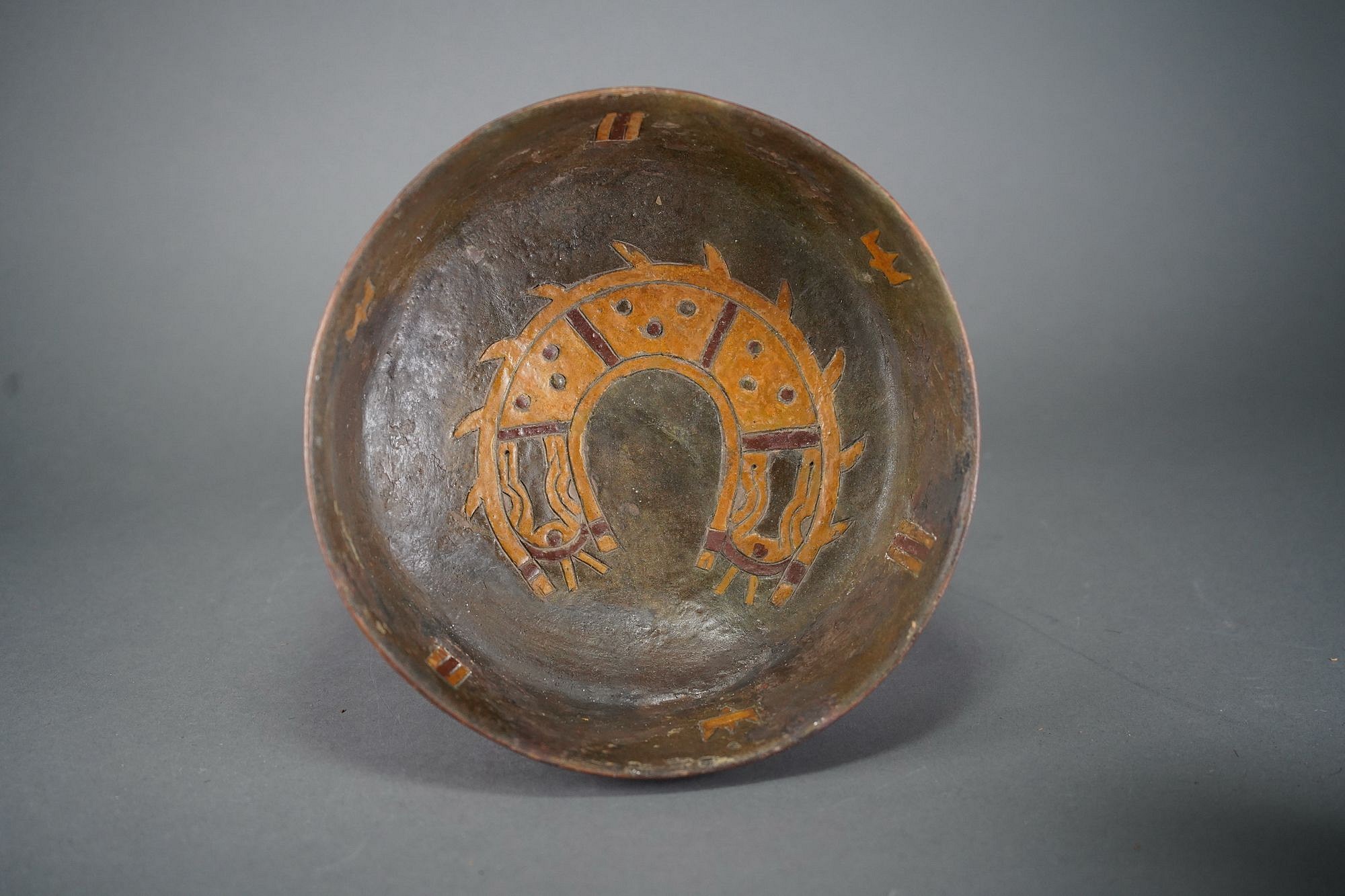
Peru, Paracas Dish with Double-headed Serpent
This painted dish is illustrated with a curved double-headed serpent, painted on the inside of the bowl as is characteristic of the later Callango phases. The double- headed serpent is a primal, animistic motif that originated early in Andean art history, during the Chavin period and is believed to depict an actual reptilian species known as Amphisbaena fuligoninos. This strange nocturnal species, which can currently be found in Ecuador down to Chile, possesses genetic traits of both snakes and worms. Although the amphisbaena snakes do not actually possess two heads, they evolved a tail that closely resembles their head as a defense mechanism against potential predators. When threatened, the amphisbaena species displays confusing behavior, acting as if its tail is a second head. The element of surprise diverts the attention of predators, creating confusion. While the predators are deliberating about which head to attack, the Amphisbaena snake buys itself time to escape. If attacked, there is a 50/50 chance the snake’s real head will be struck, allowing for an increased chance of survival. Ancient shamans likely revered the snakes for their deceptive qualities and used their non-lethal, paralytic venom for medicinal properties.
New York private collection prior to 1980.
Cracks professionally restored with some inpainting; all parts original.
Period: Peru, Paracas, Callango, Phase 8, c. 300 - 200 BC
Period: Peru, Paracas, Callango, Phase 8, c. 300 - 200 BC
Media: Ceramic
Dimensions: Diameter: 7" x Height: 2 7/8"
$5,500
M9029
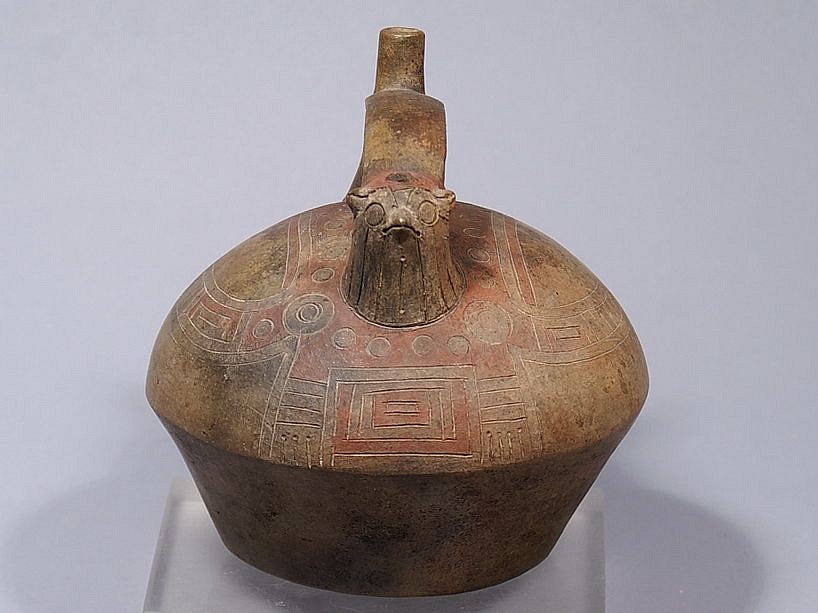







Peru, Paracas, Juan Pablo Style Falcon Bridge-spout Vessel
The blind spout at one end of the bridge handle of this vessel is modeled with a falcon's head, a typical feature of the Early Paracas style found at the Juan Pablo site. The surface on the upper body of the vessel has been delicately incised and painted to show the outstretched wings and tail feathers of the falcon. The falcon's body is decorated with circular pelt markings in a precise arrangement, with clearly delineated talons. The lower portion of the body has been left undecorated, as it would have been buried in the desert sand. The overall color scheme consists of red, orange, ochre, black, and cream pigments. This is a beautifully preserved example of Phase 3 of the Early Paracas period, in contrast to most Juan Pablo vessels which have been heavily restored. Similar examples of this style are illustrated and discussed in Alan R. Sawyer's "Ancient Peruvian Ceramics: The Nathan Cummings Collection," published by The Metropolitan Museum of Art, New York in 1966. Ex Collection of Jerome Pustilnik, acquired from Alan Lapiner prior to 1970.
Period: Peru, Paracas, Ocucaje, South Coast, c. 300 - 200 BC
Period: Peru, Paracas, Ocucaje, South Coast, c. 300 - 200 BC
Media: Ceramic
Dimensions: H. 5 3/4 x L. 5 1/2 in.
$8,500
91002
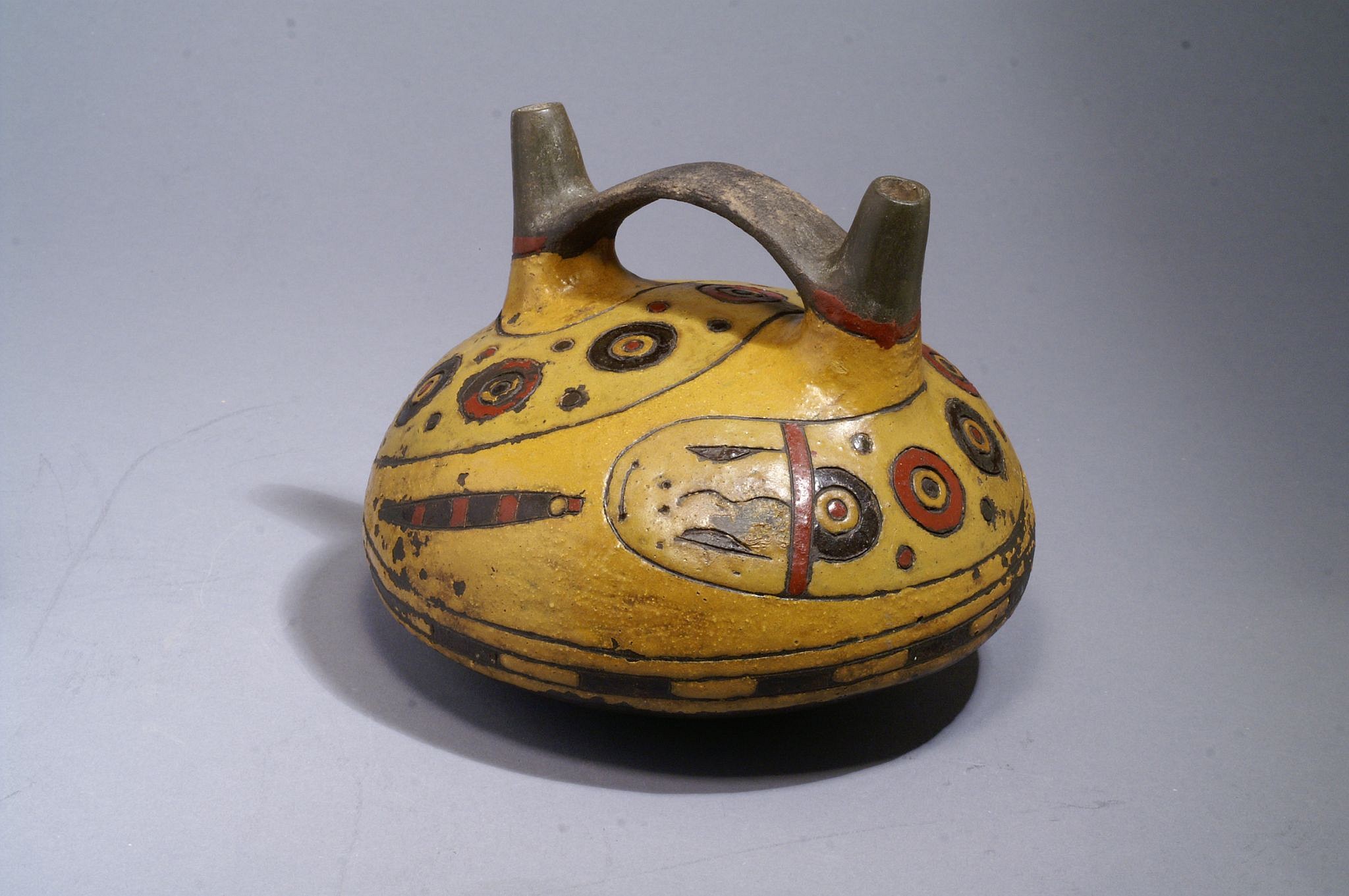



Peru, Paracas Bridge Spout Vessel Painted with Double-headed Undulating Eel
This vessel was painted with two neighboring hues of neutral yellow resinous paint, one for the ground and the other for the double-headed serpent. The rare color palette of this vessel departs from that of most Paracas vessels, which generally employ starkly contrasting colors. The animal depicted in the painting is probably an Amphisbaena, a species of worm-like snakes whose tails resemble heads as an evolutionary adaptation to fool predators. Acquired from a Miami collector in 2006.
Period: Peru, Paracas, Ocucaje Phase 9, Ica valley, South Coast, c. 300 - 200 BC
Period: Peru, Paracas, Ocucaje Phase 9, Ica valley, South Coast, c. 300 - 200 BC
Media: Ceramic
Dimensions: Diameter: 6 1/4" x Height: 5"
$8,750
M6088
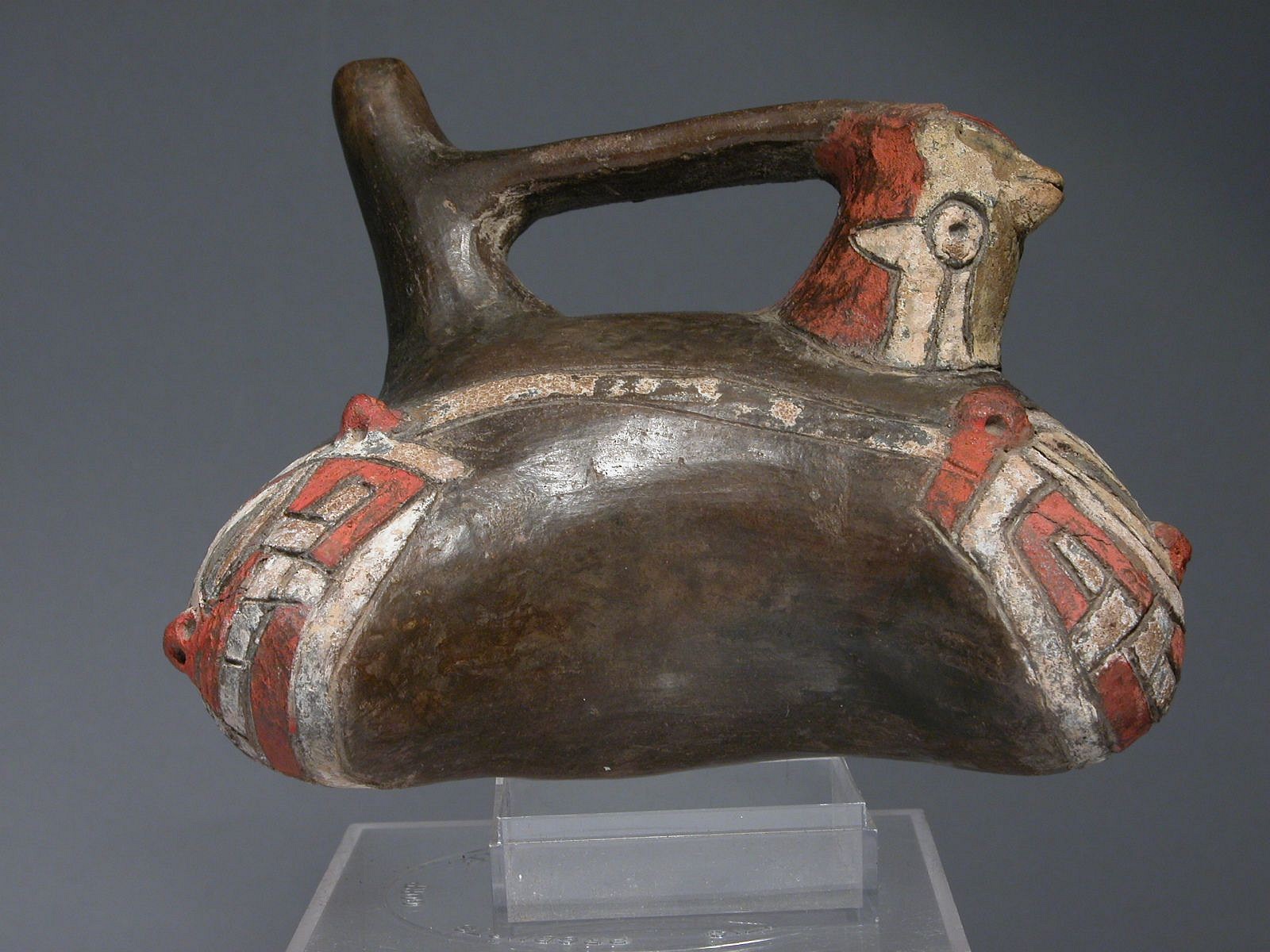
Peru, Paracas Callango Bridge Spout Effigy Vessel
This early "Callango" style vessel was painted with post-fire red and white pigments. This vessel combines two classic Andean elements: the eared falcon and the double-headed serpent. The bridge has a blind spout decorated with an eared falcon, while the body represents the double-headed Rainbow Serpent, a key figure in Andean cosmology. The double-head serpent motif originated during the Chavin period, and likely represents the Amphisbaena fuligoninos – a snake that appears to have two heads to intimidate predators. Both the eared falcon ad the double-headed snake motifs are illustrated in Christopher Donnan’s, "Ancient Peruvian Ceramics" in plates 51 and 2. Acquired from Christie’s in 1998, previously in an old estate prior to 1970.
Period: Peru, Paracas, Early Phase, South Coast, c. 900 - 600 BC
Period: Peru, Paracas, Early Phase, South Coast, c. 900 - 600 BC
Media: Ceramic
Dimensions: Length: 5 1/2 x Height: 4"
$4,750
98429b
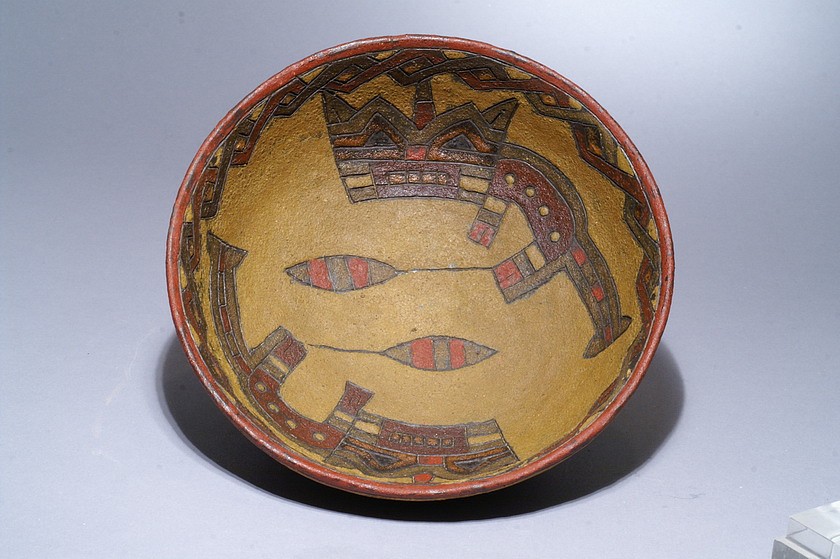
Peru, Paracas Ceramic Dish with Two Cats
Paracas ceramicists decorated much of their pottery with incised designs painted with post-fire fugitive pigments. In this example, two reclining felines adorn the interior sides of the bowl each holding a fruit or vegetable. Because of its relatively large size it suggests that it is Manioc, which is highly nutritious. Feline motifs and geometric images were common in early Paracas pottery. (Sawyer 1966: 108-109). On the outside of the bowl is a wide band in dark green with diamonds in alternating colors. Dawson identifies this design as Middle Phase Ocucaje 8 due to the facial details on the felines and the flared tail tips.
Very similar cats are illustrated in THE PARACAS POTTERY OF ICA, PAGE 359 & 360 figures 41 b& 42b.
Acquired by David Bernstein in 2006.
Period: Peru, Paracas, Ocucaje Phase 7, Ica valley, South Coast, c. 300 - 200 BC
Period: Peru, Paracas, Ocucaje Phase 7, Ica valley, South Coast, c. 300 - 200 BC
Media: Ceramic
Dimensions: Diameter: 6 1/4" x Height: 2 3/4"
Price Upon Request
M6086
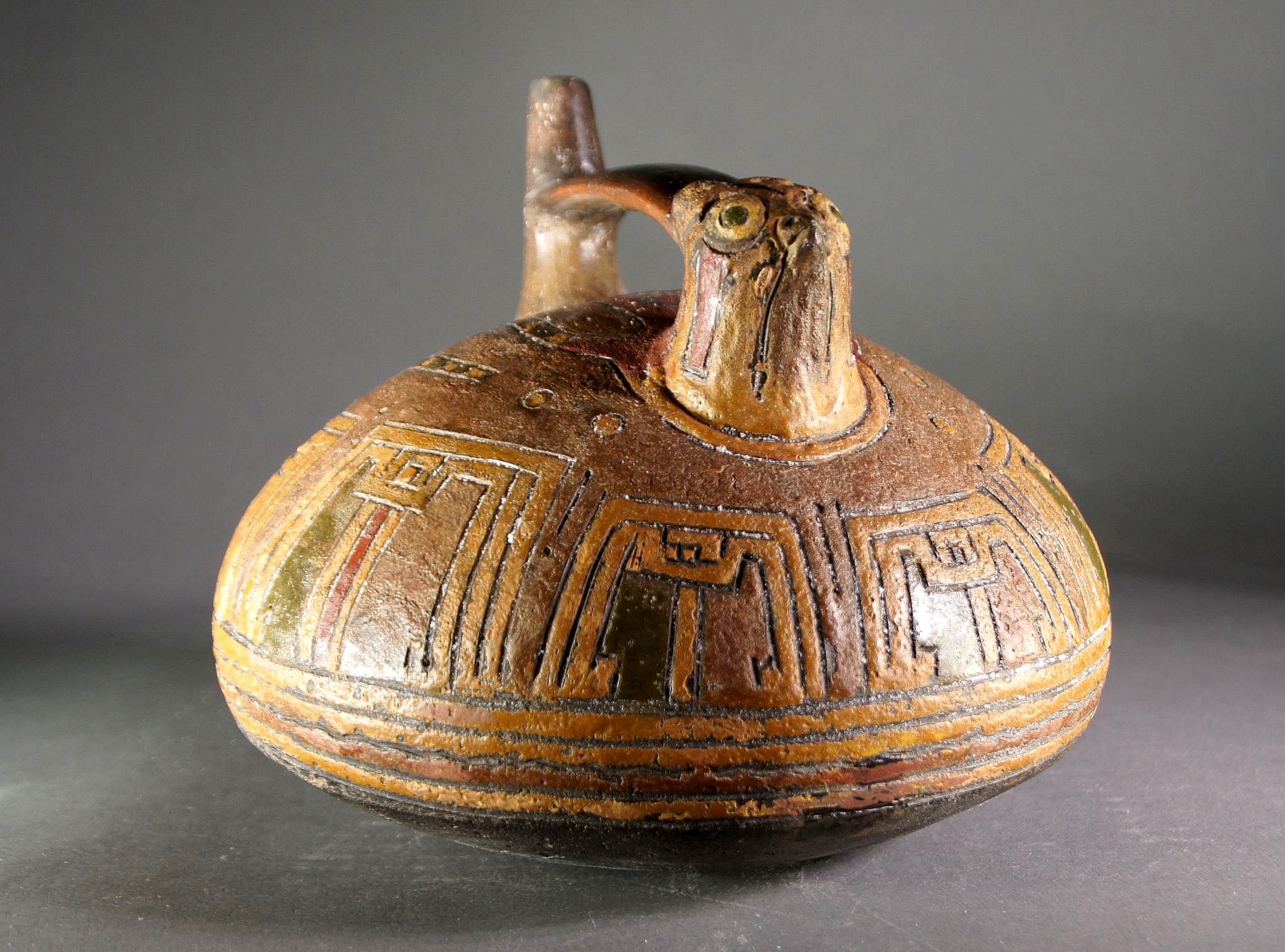







Peru, Paracas Bridge Spout Vessel with Falcon's Head
Peru, Paracas, Upper Callango basin phase 8, South Coast, c. 700 - 200 BC
This beautiful ceramic blind bridge spout vessel is crafted in the shape of a falcon with a sculpted head and incised drawings to create the falcon’s body and wings. The chamber was enhanced with a series of squarish "U" shapes, accented with a single Chavinoid eye in profile. The vessel is decorated with post-firing slip colors of red, green, brown, and tan. A similar vessel is illustrated ANCIENT PERUVIAN CERAMICS: THE NATHAN CUMMINGS COLLECTION, pages 116 & 117. A detailed discussion regarding these vessels can be found in THE PARACAS POTTERY OF ICA - A STUDY IN STYLE AND TIME on page 333.
Period: Peru, Paracas, Upper Callango basin phase 8, South Coast, c. 700 - 200 BC
Period: Peru, Paracas, Upper Callango basin phase 8, South Coast, c. 700 - 200 BC
Media: Ceramic
Dimensions: Height: 5 in. Diameter: 6 in.
Price Upon Request
n2044C
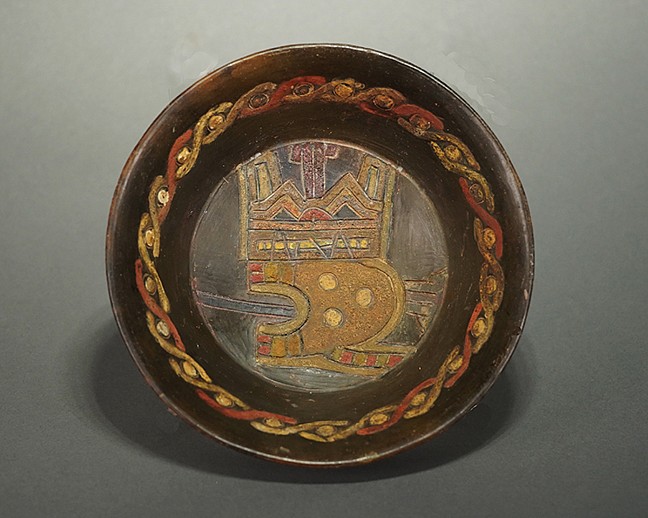





Peru, Paracas Phase 8 High Fired Ceramic Flared Dish with Feline in Profile
The dish is incised and painted with a feline in profile looking outwards. His pointed ears and brows are from Callango, phase 8. The upper edge is painted with a geometric intertwining helix design in red and yellow. On the outside rim is an incised and painted band of three intertwined designs. A similar dish is described in THE PARACAS POTTERY OF ICA by Menzel, Rowe, and Dawson, U.C Berkley, 1964, page 125, figs. 19-5k, and page 363, fig. 45. Estate of Ernst Barash prior to 1969.
Period: Peru, Paracas, Callango, Phase 8, South Coast, c. 700 - 200 BC
Media: Ceramic
Period: Peru, Paracas, Callango, Phase 8, c. 300 - 200 BC
$4,000
n4047
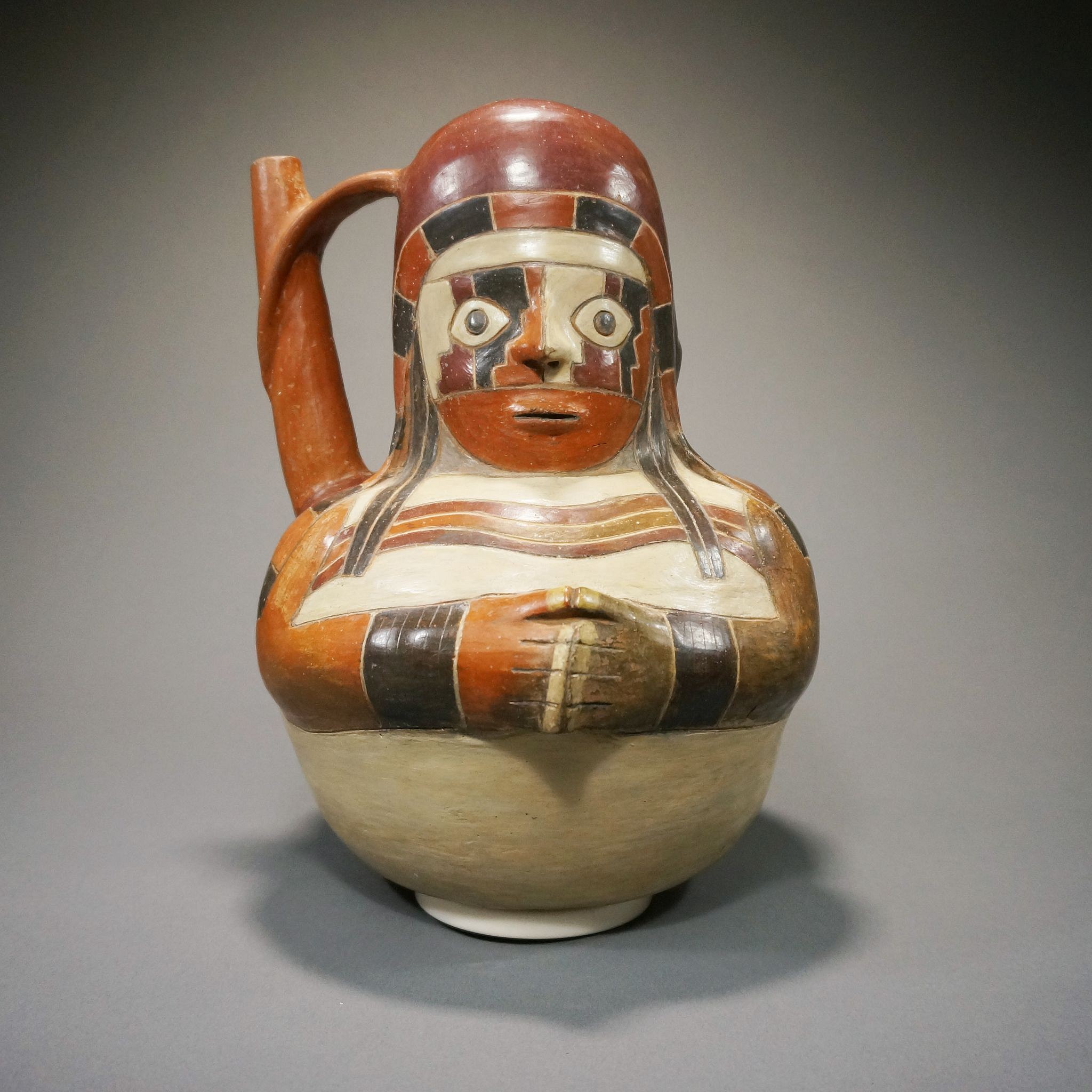
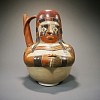


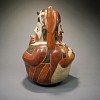
Peru, Proto Nasca Janus Head Effigy of a Smoker
This rare Nasca Janus-headed shaman has two faces, one on either side; both faces depict the same individual who morphs in behavior as the vessel is rotated, telling a narrative story. At the starting side of the narrative, the shaman is smoking a psychoactive plant, possibly tobacco combined with another entheogen. When the vessel is rotated, the same shaman has his face painted and is starring as if he is in a trance. In addition, he is seen wearing an elaborate ritual garb that includes a headdress, a face mask with a step-fret design, and a band of three waved lines across his chest. These garments were not every day utilitarian clothing, and instead indicate a ritual shamanic costume reserved for important ceremonies. The archaeological record indicates that many ancient Andean cultures may have smoked or drank preparations that contained mixtures of tobacco combined with other psychoactive substances. There are very few representations of people smoking in Andean art, but the Spanish chroniclers describe the prevalence of smoking tobacco among the Inca. The early date of this ceramic suggests the use of tobacco in Pre-Columbia as early as AD 100. Acquired in 2004 in Paris. Formerly in the collection of Jean Lions.
Period: Nasca, Proto Phase, South Coast, c. 100 BC - AD 200
Period: Peru, Nasca, Proto Phase, South Coast, c. 100 BC - AD 200
Media: Ceramic
Dimensions: Height: 10 1/4"
$28,000
M4047




Peru, Paracas Border Fringe with Five Colorful Birds
This intricate border fringe was needle-knitted with a variety of colored threads made from natural plant and mineral dyes of the Andes. The border fringe depicts 5 baby birds waiting in a nest with heads craned upwards, eagerly waiting to be fed some worms. The fringe originally had six birds - one is missing to the right of center. Excellent color. Ex. collection Ferdinand Anton, Germany, prior to 1980. Mounted on neutral cream-colored mat.
Peru, Paracas, Late Phase, South Coast, c. 200 BC - AD 100
Period: Peru, Paracas, Late Phase, South Coast, c. 200 BC - AD 100
Media: Textile
Dimensions: Width: 6 1/2" x Height: 1 1/2"
Frame : 16" x 10"
$500
79040
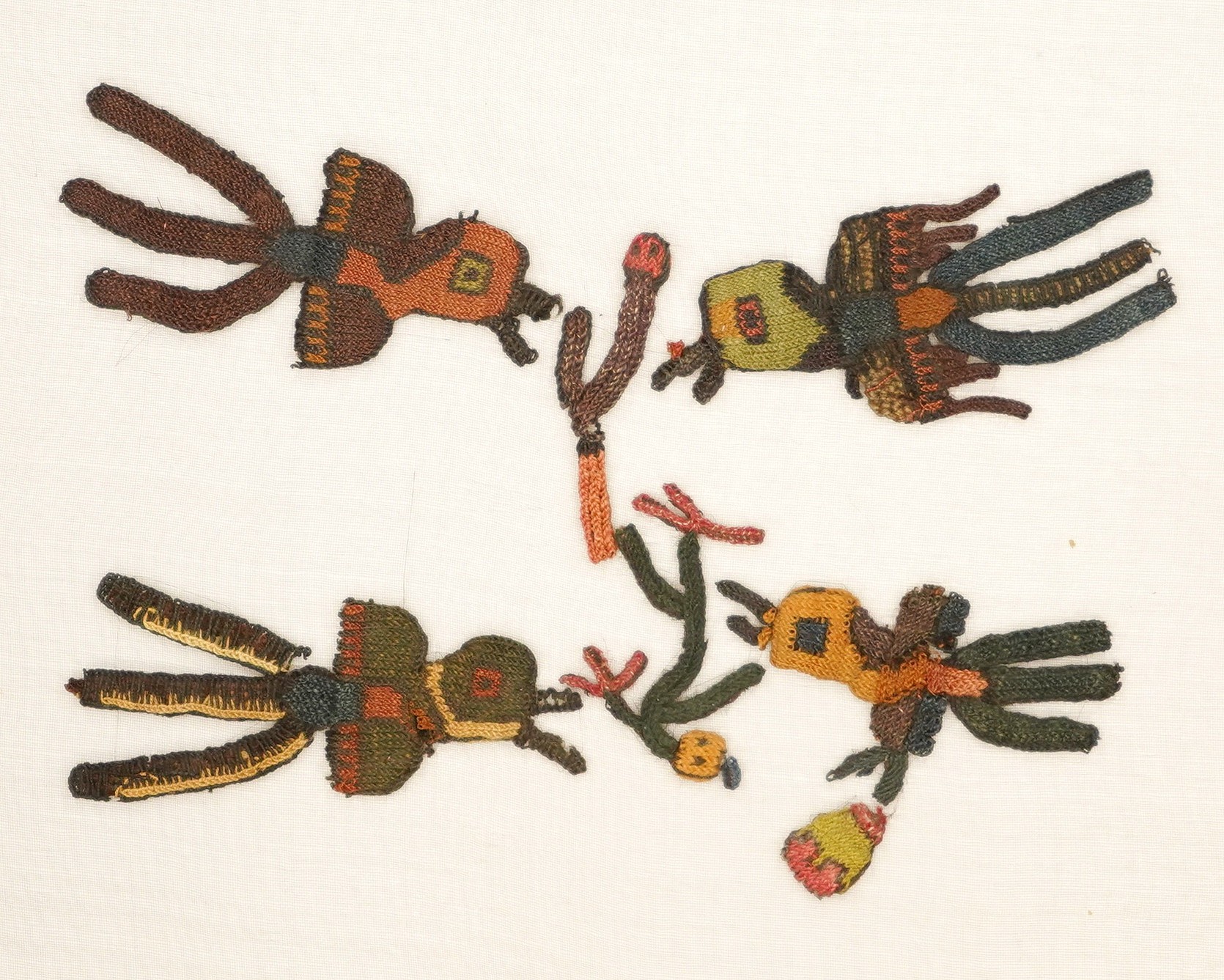
Peru, Four Paracas Embroidered Nightjars
This beautiful series of Nightjar birds is mounted on a fine netting with embroidery on both sides but is displayed on a white backing for ease of viewing. Nightjars are identifiable by the two extremely long feathers which extend down beyond their tails, possibly as a display to attract mates. The Nightjar, a nocturnal bird of prey, is a rare subject in Andean art; most birds depicted are picaflors or hummingbirds. These Nightjars are seen feasting on clusters of small snakes that resemble garter snakes. Excellent color. Ex. collection Ferdinand Anton, Germany, prior to 1980.
Peru, Paracas, Late Phase, South Coast, c. 200 BC - AD 100
Period: Peru, Paracas, Late Phase, South Coast, c. 200 BC - AD 100
Media: Textile
Dimensions: Width: 6" x Height: 4"
Mounted: W: 20" x H: 16"
$1,600
79042
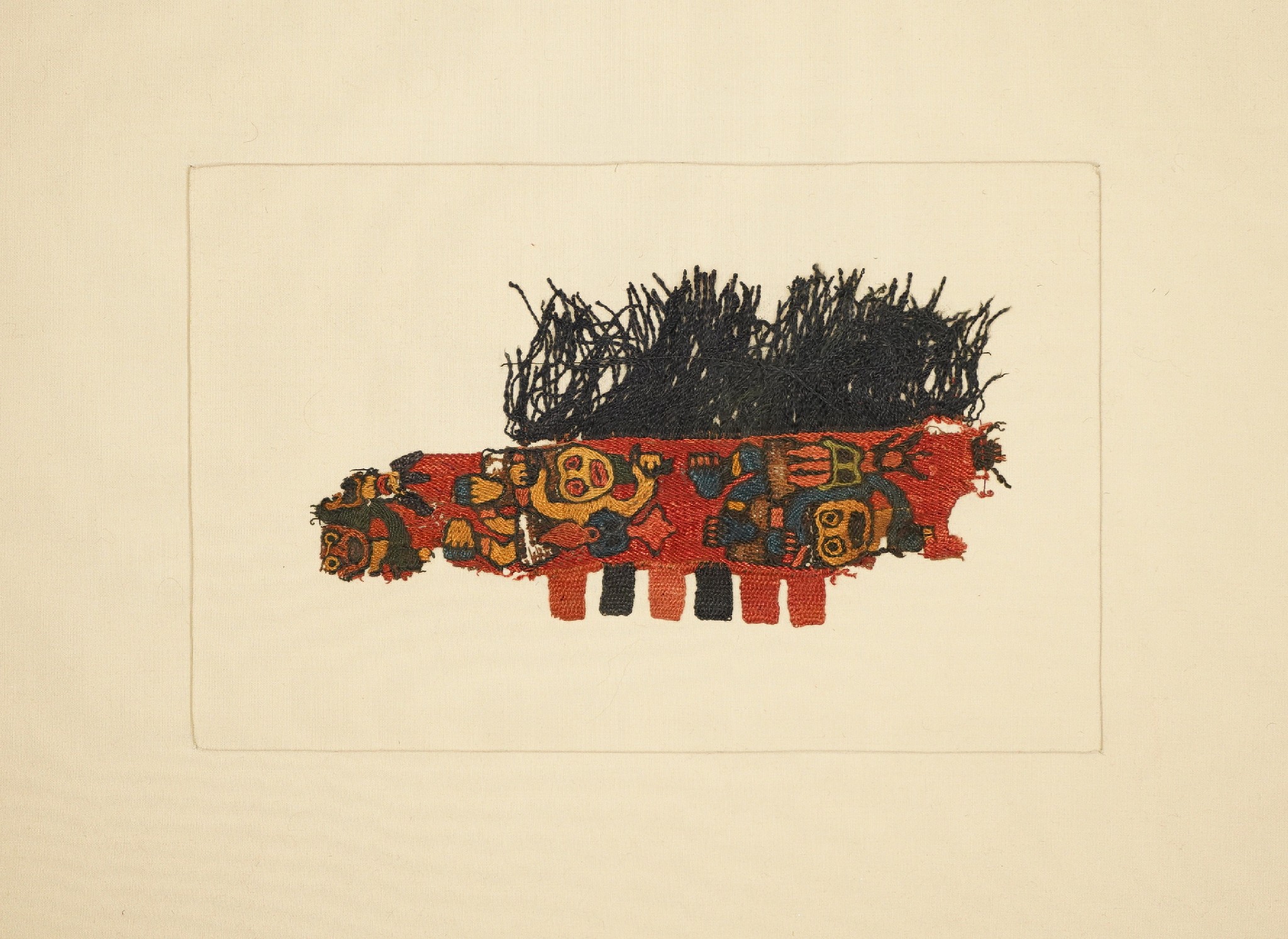


Peru, Paracas Color Block Border Section with Flying Shamans
This Paracas Color Block border section features two flying shamans, both depicted in the same position but reversed (one is upside down) to enhance the perception that they are flying or floating. Each shaman is depicted with a different color palette of bold, contrasting colors including vivid reds, oranges, yellows, and teal, which is characteristic of the Color Block style.Ex. collection Ferdinand Anton, Germany, prior to 1980.
Peru, Paracas, Late Phase, South Coast, c. 200 BC - AD 100
Period: Peru, Paracas, Late Phase, South Coast, c. 200 BC - AD 100
Media: Textile
Dimensions: Border: W. 6 1/4 in. x H. 3 1/4 in. with fringe.
Frame: W. 20 in x H. 16 in.
$600
79143













